
66 minute read
The Results: the Dataset, the “Platform Urbanism Data Sharing Policy Hub” and Resultant Policy Analysis
Figure 14. The Platform Data Sharing Policy Hub – Home Page80
Our team aggregated over 70 data sharing policy documents enacted by nearly 60 different local government agencies, covering over 40 local jurisdictions, spanning over 20 US states, and four countries. Metadata for each policy was gathered, structured into a database, and made available via our online resource hub the “Municipal Data Sharing Policy Hub”81, later renamed the “Platform Urbanism Data Sharing Policy Hub.”82
80 “Platform Urbanism Data Sharing Policy Hub.” 81 “Introducing The Municipal Data Sharing Mandate Policy Hub | Belfer Center for Science and International Affairs,” accessed April 10, 2022, https://www.belfercenter.org/publication/introducing-municipal-datasharing-mandate-policy-hub.
82 “Platform Urbanism Data Sharing Policy Hub.”
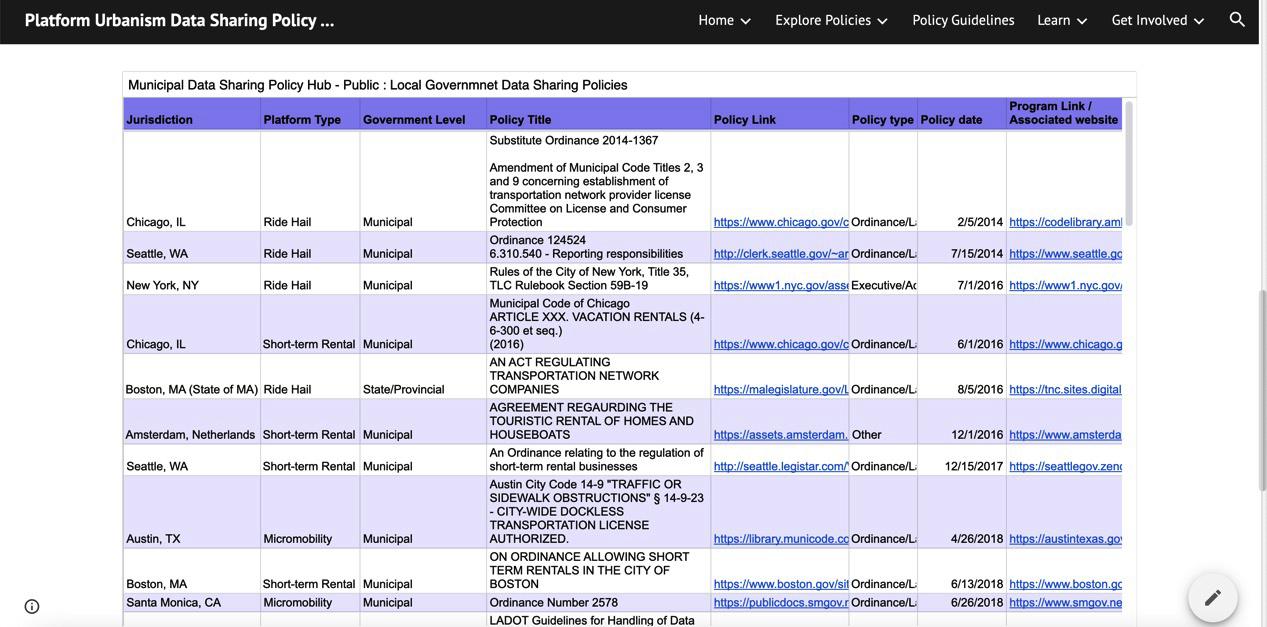
Figure 15. Platform Urbanism Data Sharing Policy Hub – Policy Database83
The PUDS Policy Hub shares these policies not only as an open database, but also as a map, document repository, and interactive data dashboard. The PUDS Policy Hub additionally includes best practice “Policy Guidelines” that will be covered in greater detail in Part 3 of this report, as well as further supplementary materials, including an open reading list, blog posts, and video content all designed to support researchers and practitioners seeking to understand, critique, improve or implement new platform data sharing approaches in cities.
83 “Platform Urbanism Data Sharing Policy Hub - Policy Map & Database,” accessed May 18, 2022, https:// sites.google.com/view/datasharingpolicyhub/explore-policies/policy-map-database.

Figure 16. Platform Urbanism Data Sharing Policy Hub – Policy Map84
Basic Analysis - Platform Data Sharing Policies by the Numbers
While our team did not seek to utilize the policy database as a representative sample for robust statistical analysis, the process of aggregating, structuring and organizing the policies allowed for some basic analysis and presentation of information summarizing counts, patterns and trends for the policies we were able to find and observe.
Enacting agencies
Our policy dataset included 58 different local government enacting agencies (corresponding to the “originating body” field in the database), covering 10 public agency categories (“originating body category” in the database):
• Department of Transportation
• Council/Legislature
• Department of Public Works
• Consumer Protection
• Special Board or Commission
84 “Platform Urbanism Data Sharing Policy Hub - Policy Map & Database.”
• Business Licensing
• Department of Engineering
• Chief Executive
• Operations Department
• Planning Department
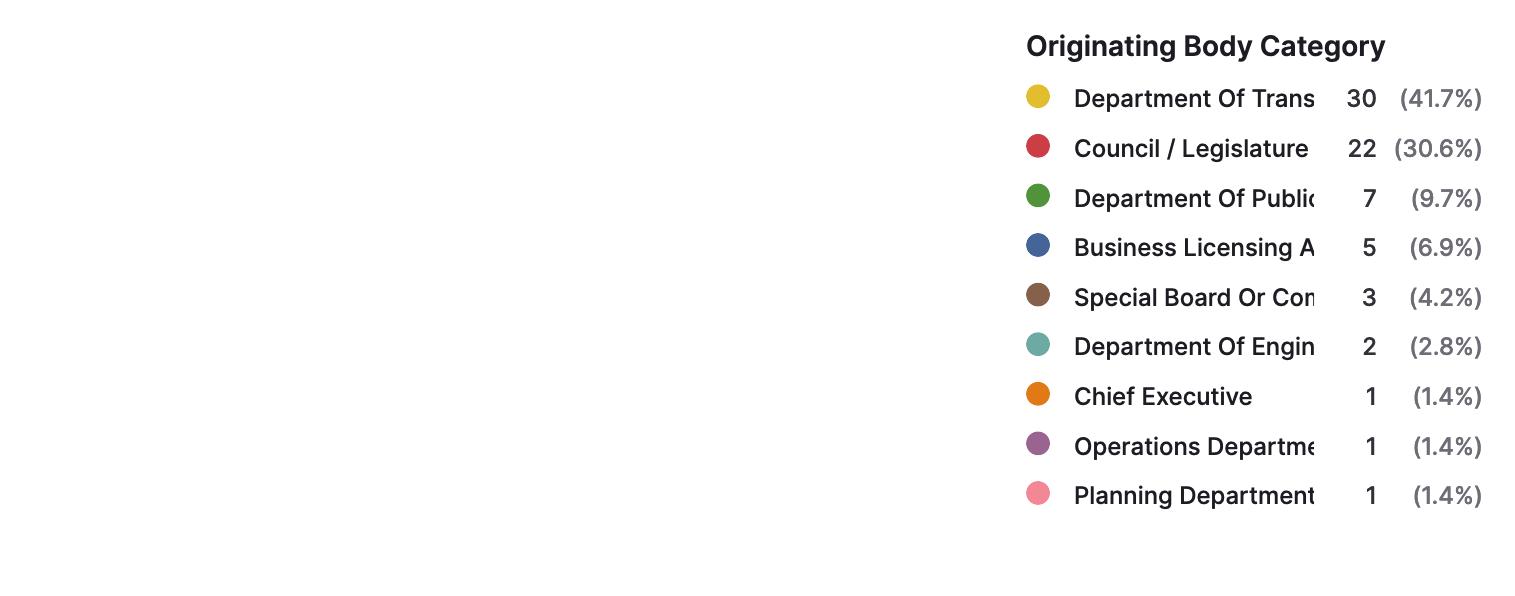
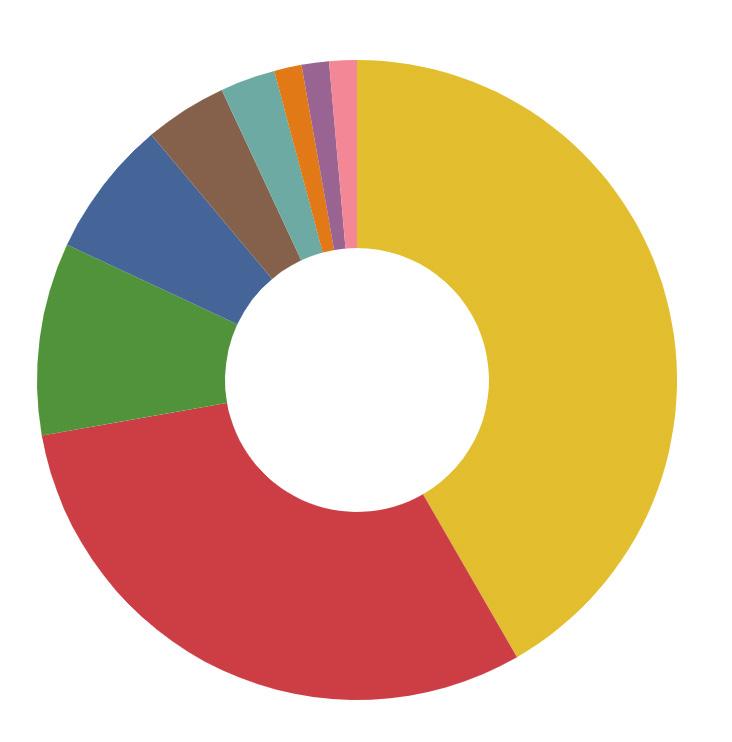
Figure 17. “Platform Urbanism Data Sharing (PUDS) Policies by Originating Body Category.” Over 70% of PUDS Policies observed were enacted by DOTs or Legislatures.
As shown in Figure 16, the vast majority of these agencies were either Departments of Transportation (DOTs) (responsible for enacting 30 policies) or Legislatures (22 policies), which together represented over 70% of the policies gathered. Other departments or agencies included in the data were also related to transportation or streets, such as Departments of Public Works (DPWs) (7 policies) or certain Special Boards or Commissions (3 policies) like Taxi and Limousine Commissions.
The large number of policies enacted by local DOTs and related departments comes as no surprise, reflecting the prevalence of micromobility policies in the data set and the fact that both micromobility and ride-hail sharing economy platforms provide transportation options to consumers. These ride-hail or micromobility programs are often regulated in the context of street management, which most often falls under the purview of local DOTs or DPWs, two agencies that together account for
just over half of policies observed. The prominence of these departments in the data also points to the importance of Directors of Transportation and Directors of Public Works as specific public officials often heavily involved in defining new data sharing governance terms.
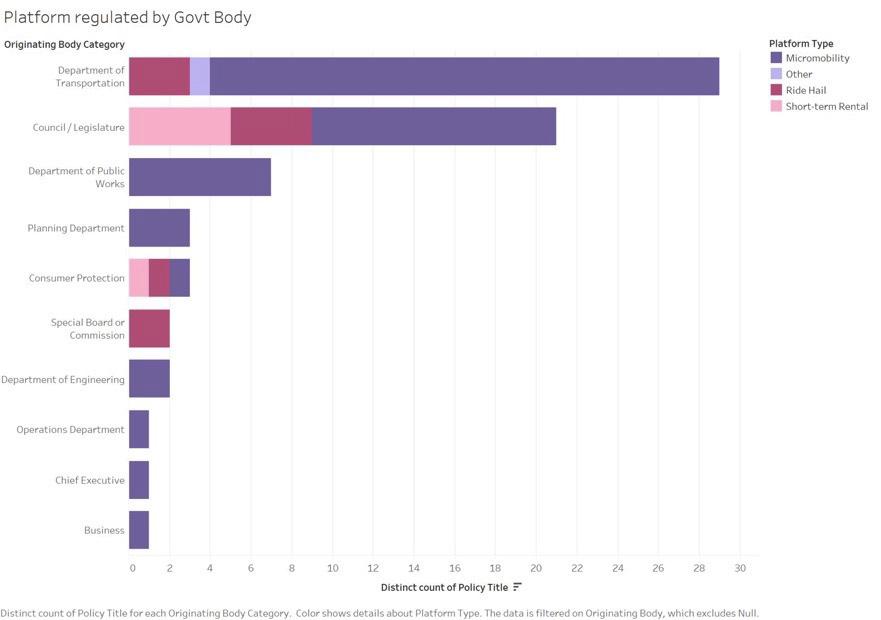
Figure 18. PUDS Policies by Originating Body Category, broken down by type of sharing economy platform regulated.
The high share of policies enacted by legislatures, responsible for about 30% of the policies observed, is also expected given that these bodies (and the individual elected officials who typically comprise them) are necessary for adopting local laws or ordinances pertaining to data sharing. The reality that only 22 out of 72 PUDS policies are enacted with the full legislative legitimacy of codified law likely reflects both the novelty of platform data sharing as a formal regulatory approach and the fact that deliberative bodies are often, by design, “slower moving” when compared to executive branch agencies. Additionally, the fact that there can be multiple executive branch policies associated with a single ordinance (for example a program that includes both administrative data sharing rules and data sharing permit requirements, both enacted by the Department of Transportation following the passage of a City Council Ordinance), likely dilutes the percentage of polices enacted by legislative bodies.
Also of note is that legislatures are overrepresented in the ride hail and short- term rental categories, with 5 out of 6 short term rental data sharing policies enacted by legislature and 5 out of 12 in the ride hail context, compared to only 12 out of 50 in the micromobility context. This is perhaps indicative of the more antagonistic and litigious nature of the early sharing economy platform launches typified by these sectors and companies like Uber and Airbnb, and the need for policy with the full force of law to compel data sharing from these more resistant companies.

Figure 19. PUDS Policies by Platform Type, broken down further by Originating Body/Agency Category. Policies enacted by a “Legislature / Council” are overrepresented in the ride hail and short-term rental platform categories.
Business Licensing (2 policies enacted) and Consumer Protection (3 policies) represent a different, but important (and perhaps underutilized) approach to platform regulation and a different kind of policy objective. This type of agency is may be best positioned to address certain kinds of platform negative externalities regardless of platform/technology type, but was an approach only taken in Chicago, Indianapolis, and Toronto.
Platform Technology Type
Unsurprisingly given the sector’s role as a catalyst for the data sharing mandate approach, a large majority of data sharing policies collected create mandates for micromobility platforms.
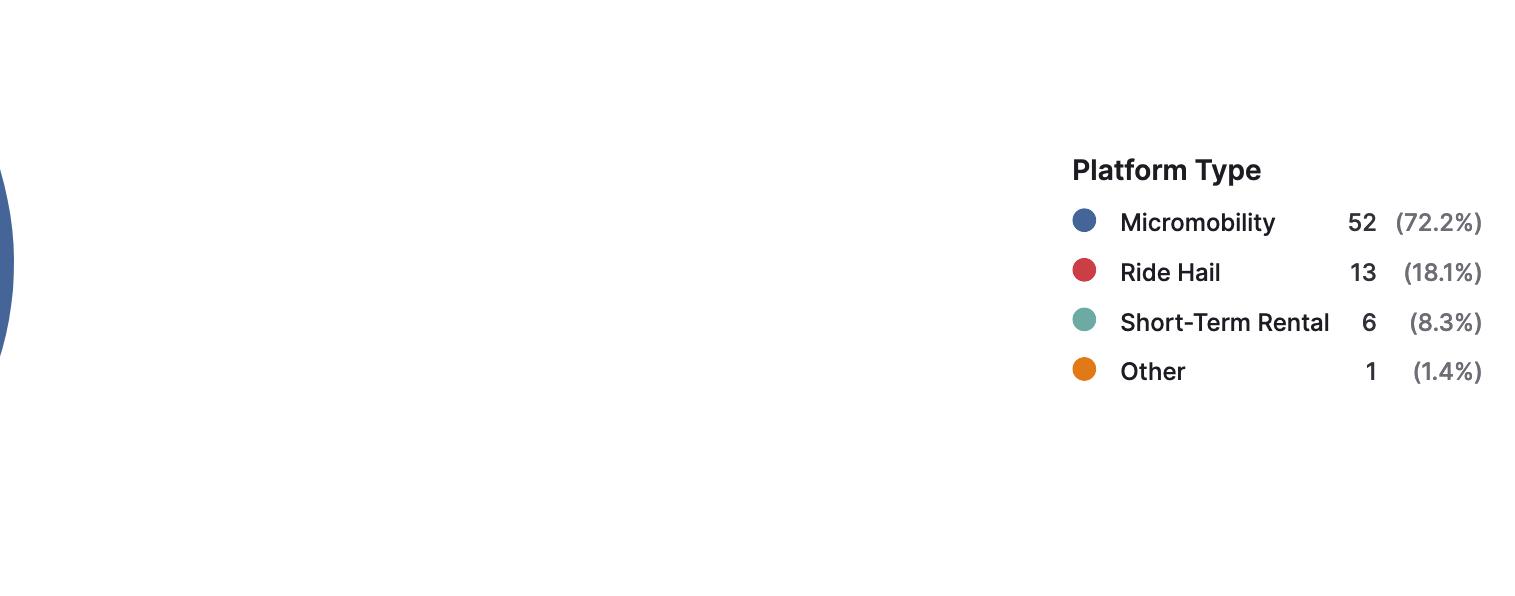
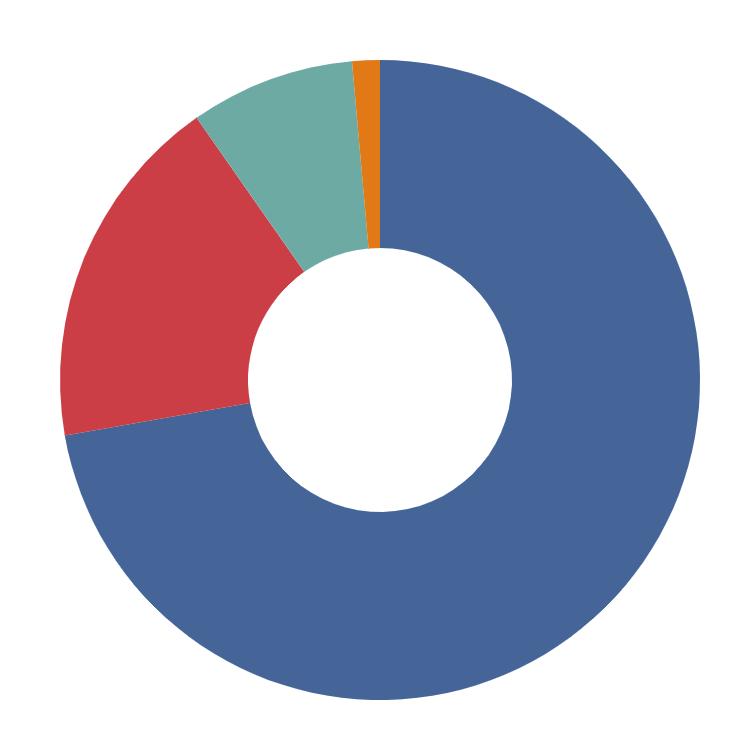
Figure 20. PUDS Policies by Type of Platform Regulated (Donut Chart). 52 out of 72 policies observed apply to micromobility platforms, representing more than 2 out of 3 PUDS polices observed.
Only 13 of the policies collected applied to ride-hail companies, and only 6 applied to short term rental platforms. Our team collected one policy from another sector, Los Angeles Department of Transportation’s data sharing requirement for “Personal Delivery Robots”, an emerging technology currently being piloted in various cities, but not deployed at the same scale as the other platforms categorized.
Somewhat counterintuitively, while micromobility platforms have been the most regulated in terms of data sharing, they are likely not the platform type with the largest impacts, externalities and risks for cities. For example, there are no drivers needing labor protection, and fewer environmental, air quality, or traffic congestion impacts on streets when compared to ride hail. This discrepancy in data sharing requirements reflected in the breakdown of PUDS policies by platform type likely instead reflects the change in leverage, dynamics and technical competencies between when early sharing economy platforms first launched in cities and more recently when micromobility first appeared. It also raises questions about consistency/ fairness and whether the data sharing regulatory approach will expand to other sharing economy platforms retroactively and to new technologies going forward as they emerge.
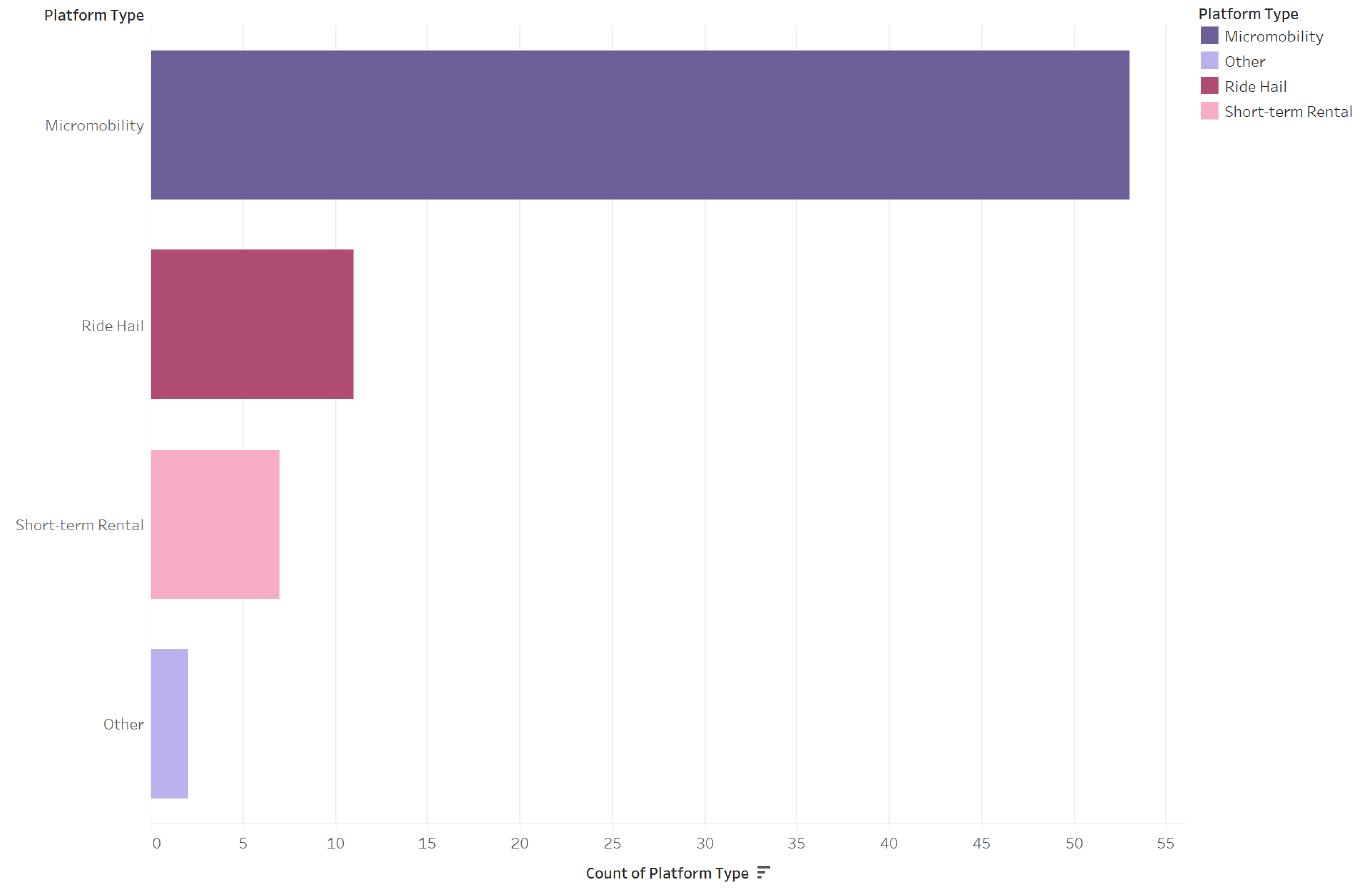
Figure 21. PUDS Policies by Type of Platform Regulated (Bar Chart). 52 out of 72 policies observed apply to micromobility platforms, representing more than 2 out of 3 PUDS polices observed.
Geography and Level of Government
Policies collected cover over 41 unique local jurisdictions, spanning 24 US states and the District of Columbia. Capturing the urban nature sharing economy platforms, the vast majority of policies in the dataset (64) represent municipal governments, with only 6 state or provincial policies represented and only 2 counties85, Arlington County, VA and Montgomery County, MD—both of which are highly urbanized counties in the DC metropolitan area.
85 Consolidated city-counties, like Louisville-Jefferson County, Nashville-Davidson County, or the City and County of San Francisco have been categorized as “municipal”.
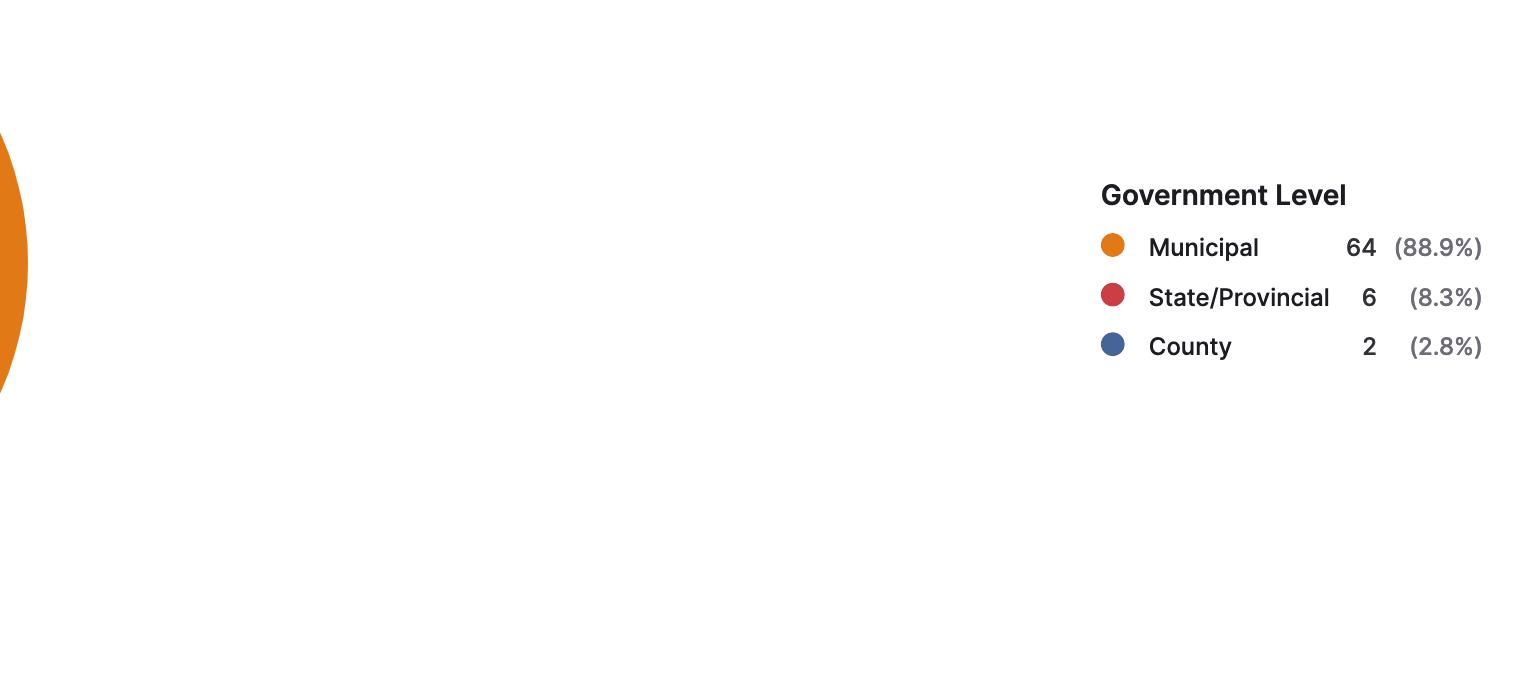
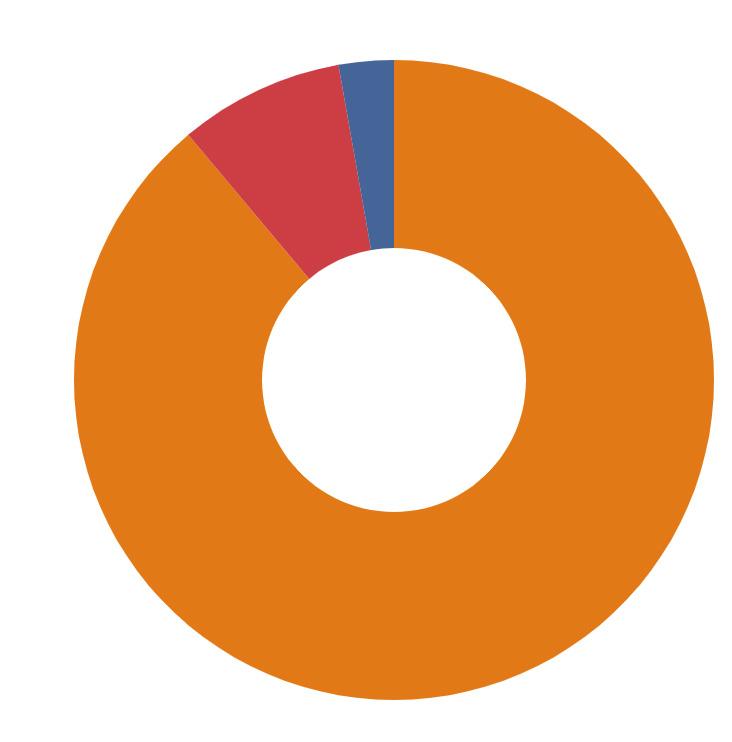
Figure 22. PUDS policies by government level.

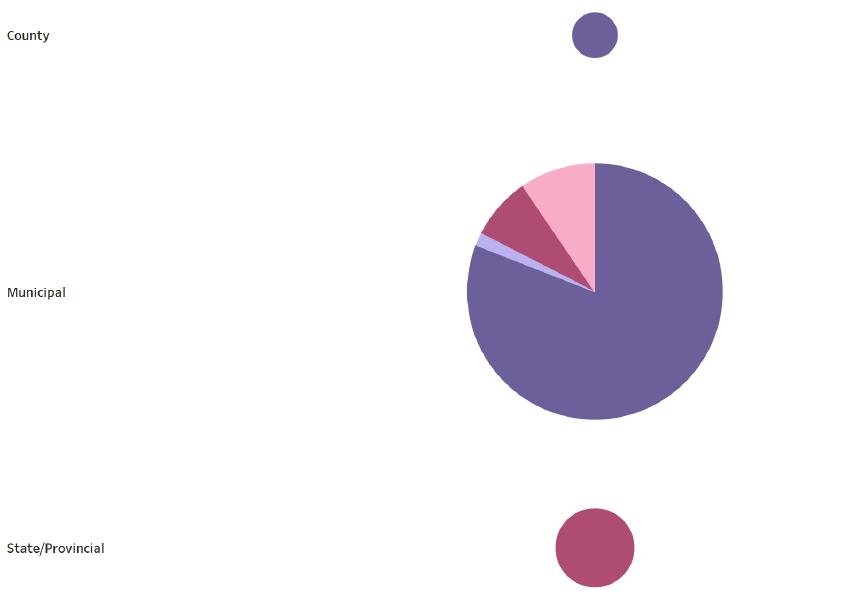
Figure 23. PUDS policies broken down further by platform type.
Of all jurisdictions, Los Angeles has the most platform data sharing policies included in the dataset with 7, with Chicago (5) and the Canadian Province of British Columbia (4) rounding out the top three jurisdictions by number of policies in the dataset.
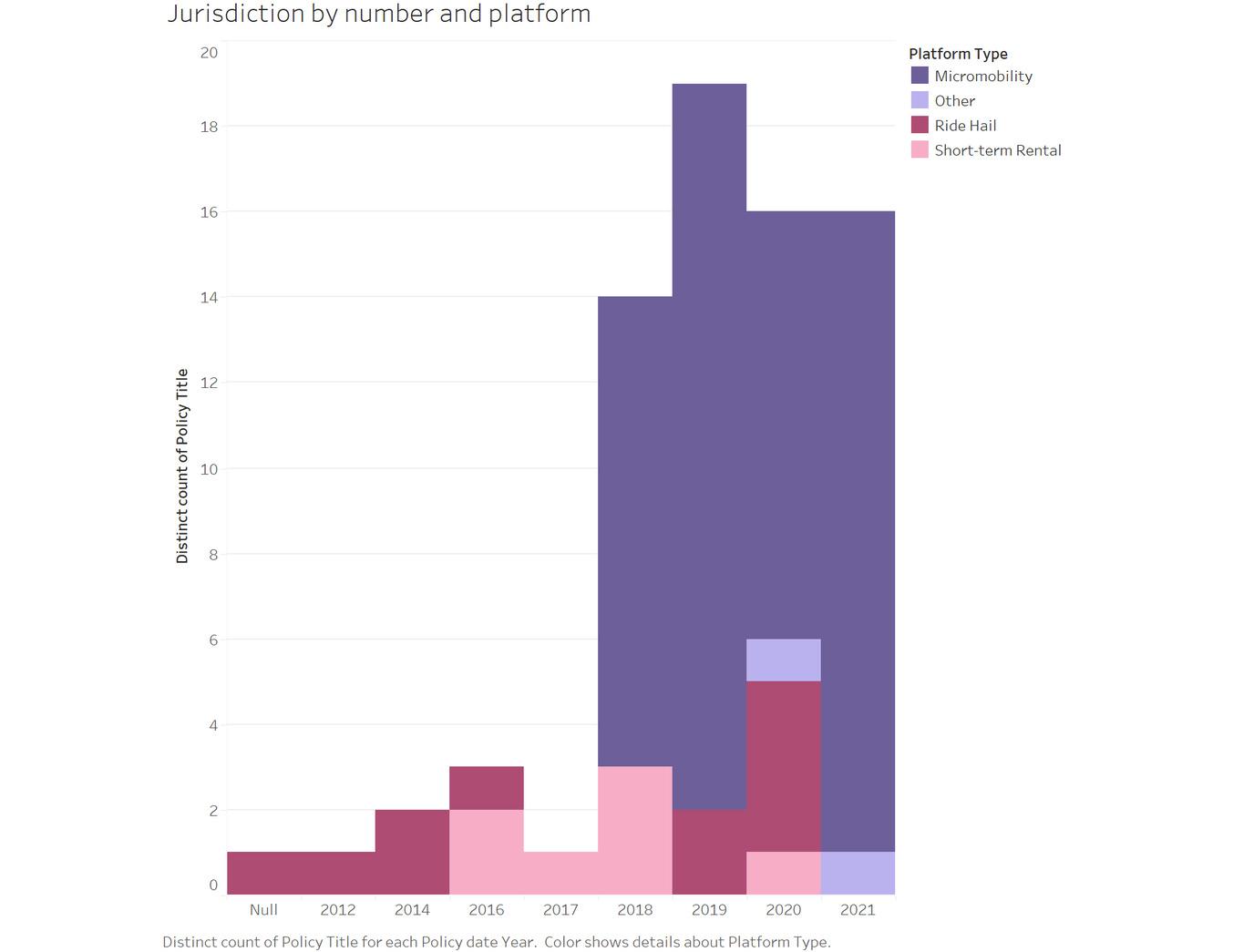
Figure 24. Jurisdictions by number of policies, broken down by platform type regulated.
Only Chicago and Seattle have policies requiring data sharing for short term rental, ride-hail, and micromobility platforms. Boston and New York City both require data sharing from ride-hail platforms and from short term rental platforms, but neither city allows micromobility platforms to operate as of writing86 so neither has a micromobility data sharing policy.
Municipal governments represented in the data set tended to be large and mid-sized cities. Policies collected included only two jurisdictions with a population under 100,000: Santa Monica, the epicenter of the micromobility sharing economy and a wealthy, tech-forward city with a municipal government known for innovation, and Charlottesville, Virginia, a college town and regional vacation destination. Only three
86 Whereas state law in Massachusetts has precluded e-scooter operation in Boston, New York City has in fact piloted shared micromobility in the outer boroughs; however, our research did not identify a corresponding data sharing policy. See: https://nycdotscootershare.info/
additional jurisdictions in the dataset represented cities with a population under 200,000: Bellevue, WA, Dayton, OH, and Providence, RI. All other jurisdictions had populations over 200,000 with 54 policies enacted in large jurisdictions with populations over 500,000. This preponderance of large cities in the dataset is unsurprising as these are the jurisdictions in which platforms are most present as well as the cities with the most technical capacity and desire for using data within agencies.
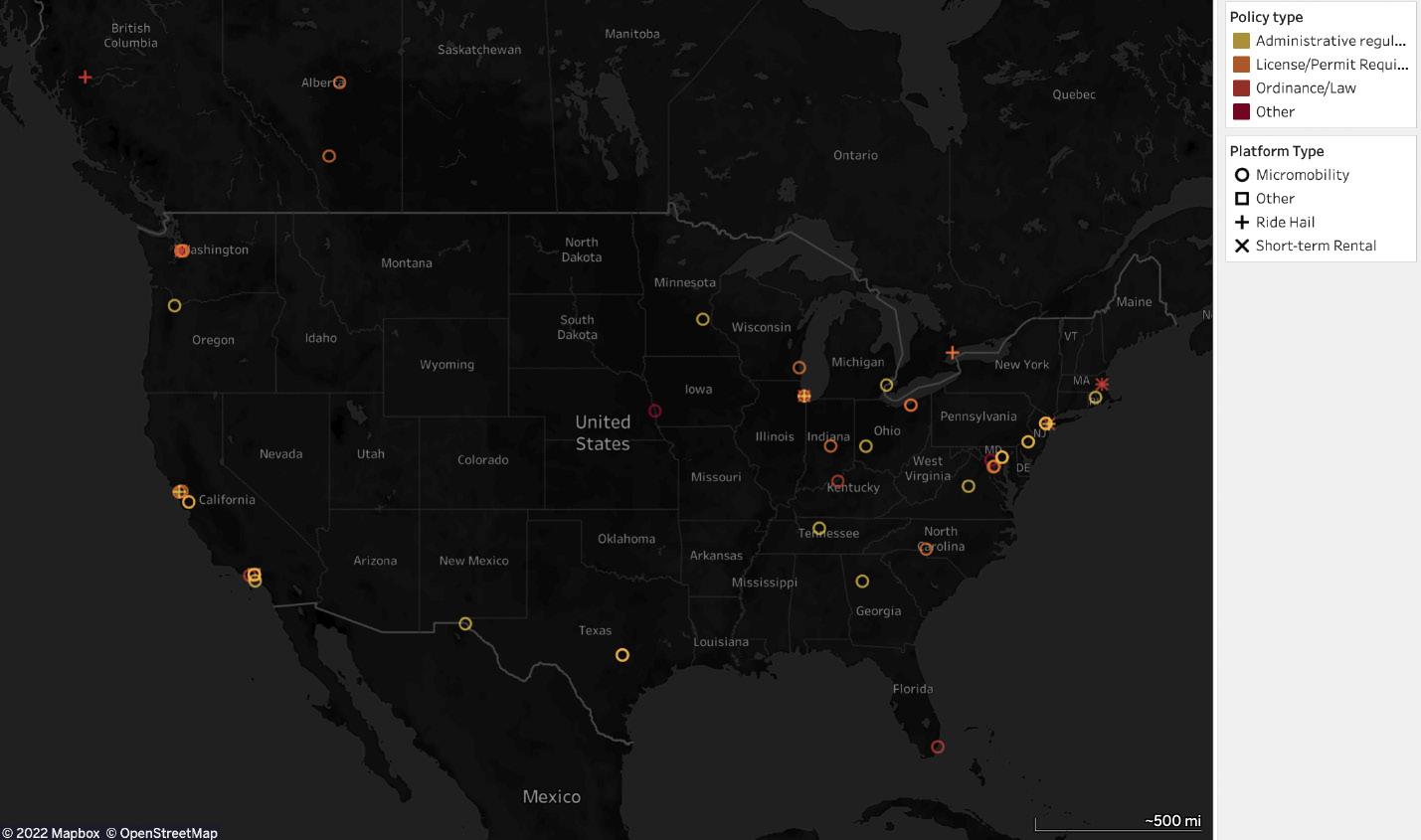
Figure 25. PUDS Policy Map (Tableau). The above map shows data sharing policies mapped by jurisdiction with icons indicating platform type.
To some extent the lack of smaller to mid-sized cities could also reflect the limits of our search methodology with cities in smaller media markets less likely to be covered by journalists in articles or by researchers in academic reports or case studies where our team looked for policies. Speculatively, our search may have missed smaller cities with certain characteristics supportive of sharing economy platforms and corresponding data sharing policies. Such cities might include jurisdictions that have high population densities or lower rates of automobile ownership, like “college town” cities where micromobility or ride-hail is likely more prevalent than population or media market would suggest, or might also include smaller cities that are highly popular vacation destinations, where short-term rental platforms are likely to be prevalent and to have had a large impact on local housing markets.
Policies by Policy Mechanism/Type
Policies in the dataset were defined as one of four policy types:
• “Ordinance/Law” – These are the policies proposed and enacted by the legislative body of a given jurisdiction.
• “Executive/Administrative Regulation” – These policies are rules or orders that originate in the executive branch of the jurisdiction, and are typically made or enacted by the authority of a chief executive, such as a Mayor or City Manager, or agency or department head, such as a Director of Transportation or Public
Works, within the bounds of existing laws or ordinances that may or may not be referenced.
• “License/Permit Requirement” – These policies refer to rules and conditions to which a business or other party—in our case a sharing economy platform—agrees as a condition of being granted a license or permit to operate in the jurisdiction.
• “Other” – This category refers to any other kind of data sharing requirement included in the dataset, including individual agreements such as Memoranda of Understanding (MOUs),
Memoranda of Agreement (MOAs), or data license agreements between local governments and individual platform companies.
It also includes additional, more supplemental policy documents, such as data privacy and protection principles, technical documentation, such as API documentation or data specification guides, as well as data sharing vision documents or plans.
These different policy categories often, or even ideally exist in interdependent ways within a single jurisdiction. For example, a city council ordinance might create the broad authority for a department director to determine appropriate sharing economy platform data needed to meet certain government objectives (“Ordinance/Law” policy type). The department director might then issue a corresponding set of program rules defining what data is needed (“Executive/Administrative Regulation” policy type), and with permit requirements spelling out the specific technical formats, fields, frequencies, and other mechanisms by which
data must be shared as a condition of receiving a permit (“License/Permit Requirement” policy type). A set of data protection and privacy principles might also be issued in coordination with the IT department committing the department to responsible data handling practice (“Other” policy type).
When taken as a whole, the PUDS policy research dataset reflects a close to even spread across these three primary policy types with 22 administrative regulations, 22 permit requirements, and 19 ordinances or laws. As is expected, the “Other” category lags at 9.
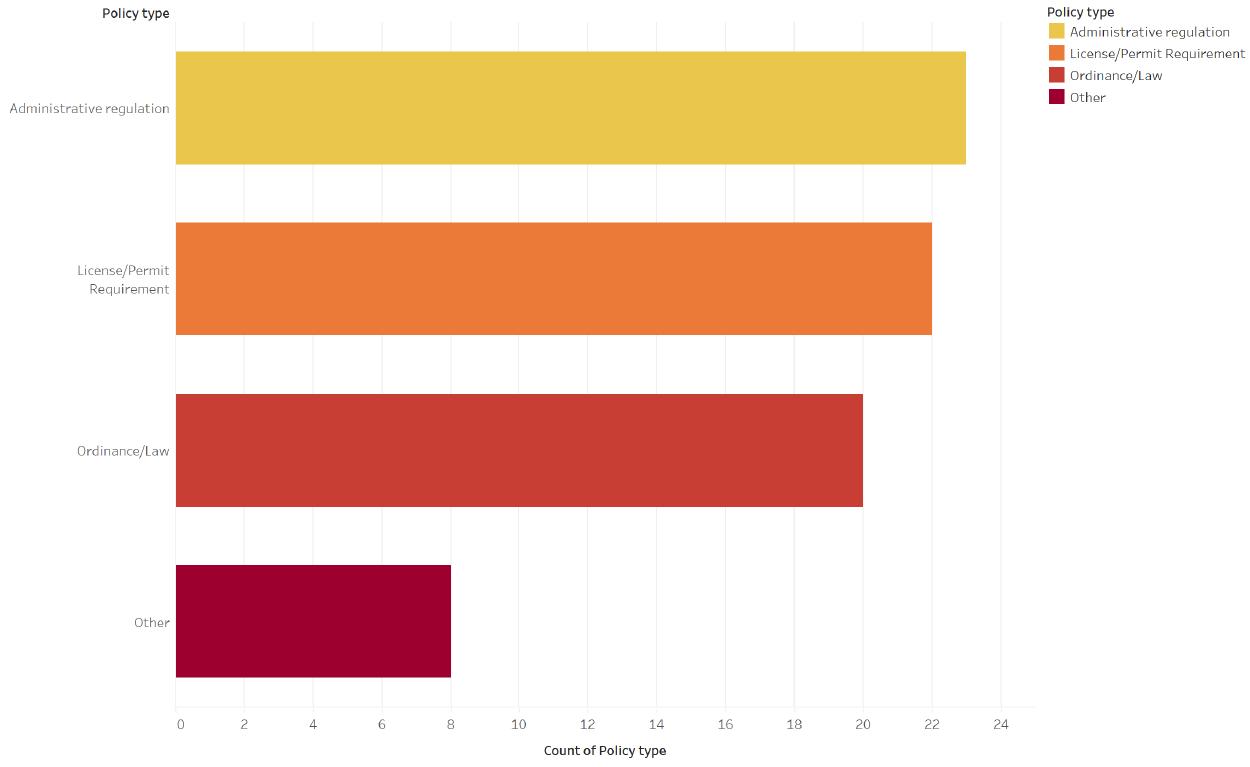
Figure 26. PUDS Policies by Policy Type

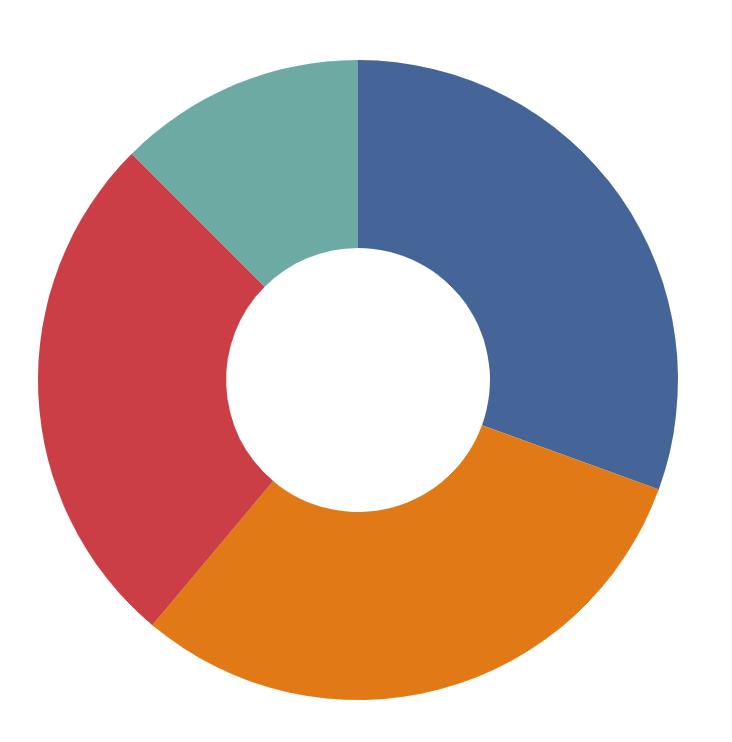
Figure 27. PUDS Policies by Policy Type with percentages. The charts show a fairly even distribution among the three primary policy type categories of “Ordinance/Law”, “Executive/Administrative Regulation” and “License/Permit Requirement”.
Broken down by platform type, however, we begin to see some interesting discrepancies.

Figure 28. PUDS Policies by Platform, broken down further by policy type. The chart shows An overrepresentation of the “Ordinance/Law” policy type in policies regulating ride hail and short term rental platforms, whereas “License/Permit Requirement” and “Executive/Administrative Regulation” are more a more common policy types for policies requiring data from micromobility platforms.
In the short-term rental and ride hail context, “Ordinance/Law” is the most common policy type, representing 10 out of the 19 total data sharing policies including nearly all of the short-term rental policies, while in the micromobility context, “License/Permit Requirement” is the most common data sharing policy type, representing 20 out of 52 total policies, with Administrative Regulations following closely behind micromobility Permit Requirements with 18. In the micromobility context, Law/Ordinance falls behind at just 9 out of 52 policies.
This discrepancy can partly be explained by the occurrence of more than one administrative regulation, permit requirement, or “other” policy under a single ordinance but may also be reflective of the stronger position of cities to regulate micromobility platforms discussed at the end of Part 1, Section 1.2 of this report, and the need for regulation with more “teeth” in the context of more resistant short-term rental and ride hail platforms.
Policies by Date Adopted
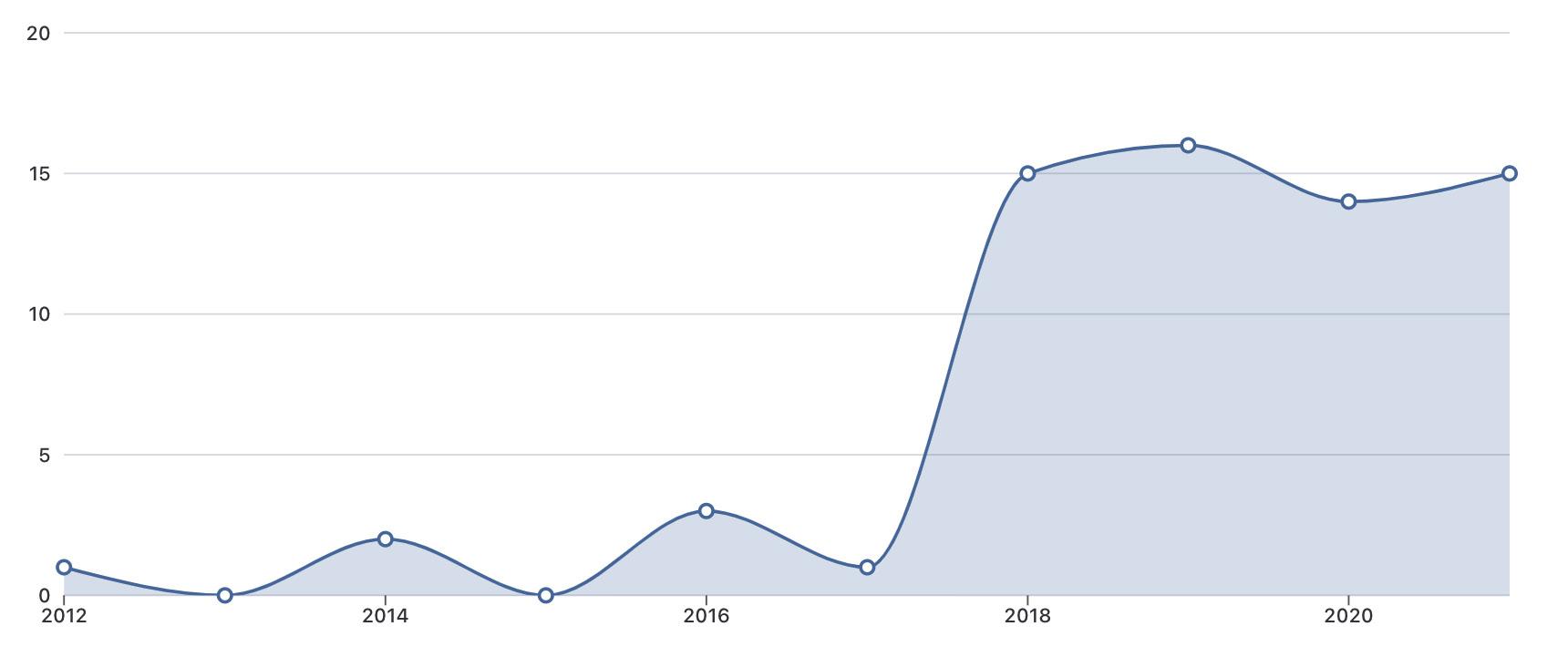
Figure 29. Timeline of PUDS policies polices enacted per year. Very few policies were adopted in the first decade of the sharing economy, prior to 2018
As has been discussed previously in Part 1, very few data sharing policies were adopted by cities during the first decade of the sharing economy, from 2008 – 2017, in a largely pre-techlash world where ride-hail and short-term rental platforms had more leverage over cities. This all changed in 2018 when we started to see many more data sharing policies particularly in the micromobility context. We see this clearly by sorting our policy dataset by date and by platform type.
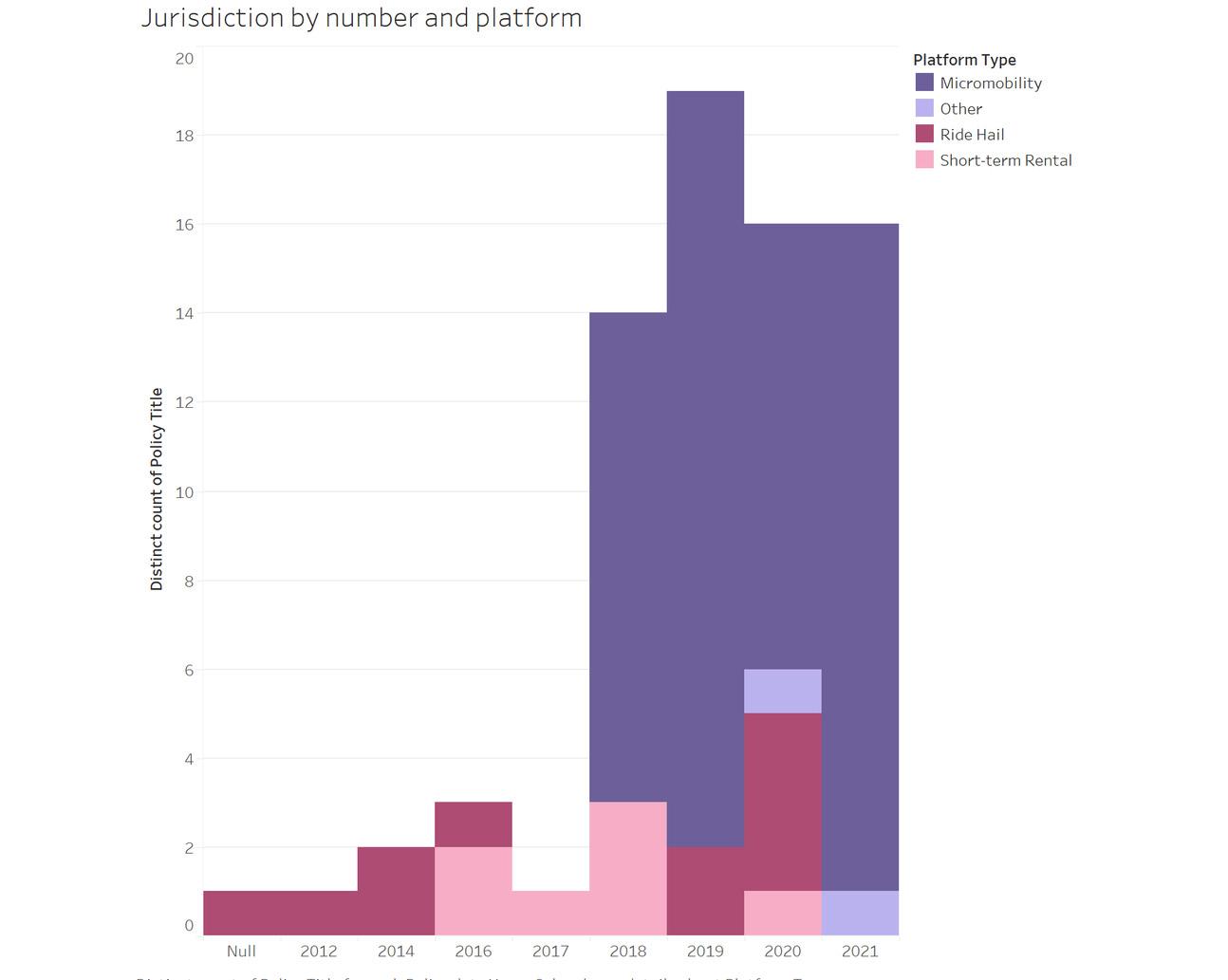
Figure 30. Policies enacted per year colored by platform type. The chart shows that micromobility platform data sharing policies are responsible for the stark increase in platform urbanism data sharing policies adopted by local governments.
Figure 31. PUDS policies by jurisdiction, by date enacted and platform type. Chart shows each individual PUDs policy and illustrates the preponderance of micromobility policies starting in 2018 while also showing which jurisdictions have adopted multiple policies.
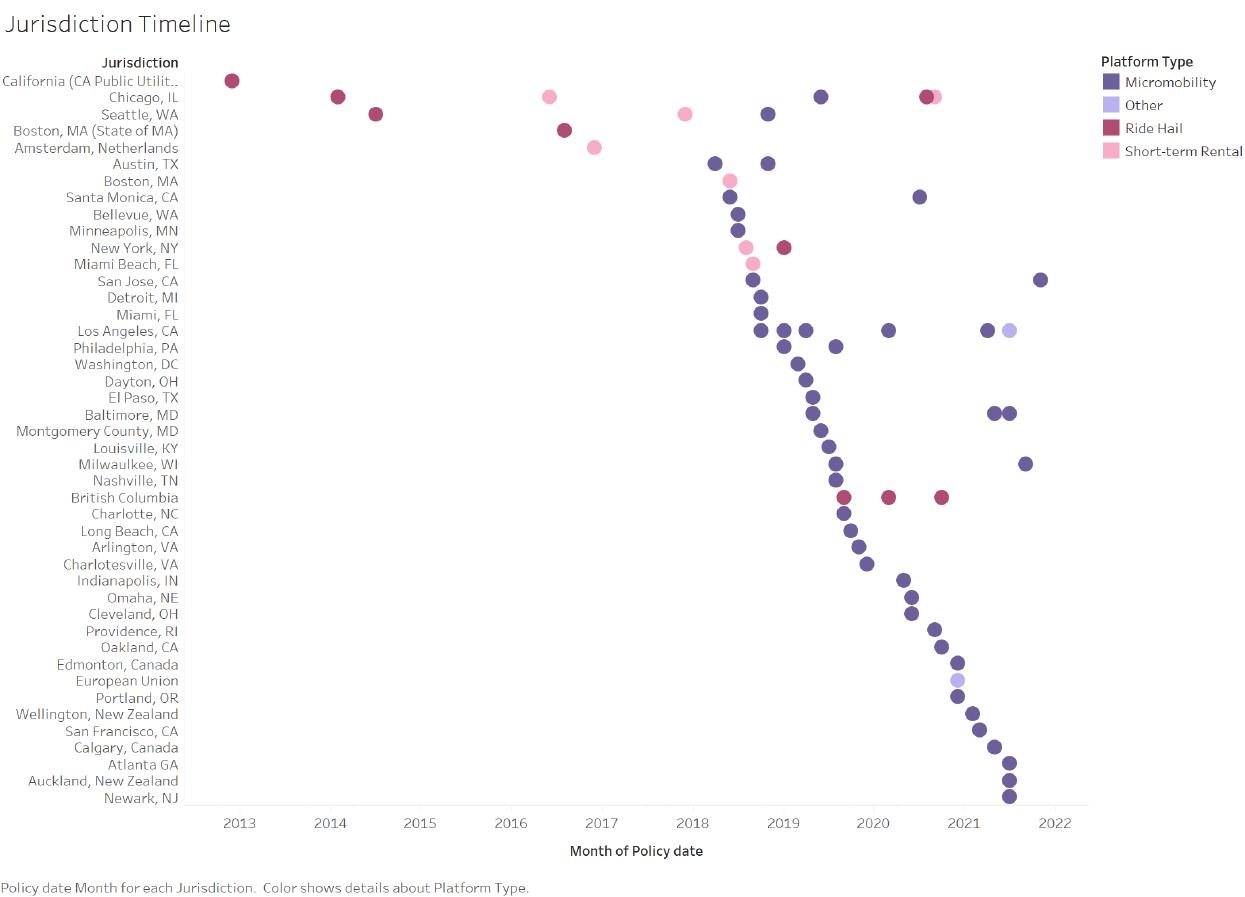
Sorting the research dataset by date of policy adoption also highlights important milestones and firsts:
• Dec 2012 - California Public Utilities Commission becomes the first local government agency in the dataset to have adopted a
PUDS policy of any kind with their “Order Instituting Rulemaking on Regulations Relating to Passenger Carriers, Ridesharing, and New Online-Enabled Transportation Services”, enacted in
December of 2012.
• Feb 2012 – Chicago becomes the first city to enact a platform data sharing mandate of any kind as well as the first jurisdiction to do so by ordinance/law with their “Substitute Ordinance 2014-1367:
Amendment of Municipal Code Titles 2, 3 and 9 concerning establishment of transportation network provider license
Committee on License and Consumer Protection” which regulated ride-hail platforms.
• Aug 2016 – The State of Massachusetts, passing a State Law that would apply only to the city of Boston, becomes the 5th local government to enact a data sharing requirement on ride hail platforms, joining New York, Seattle, and the aforementioned
Chicago and California.
• Dec 2016 – Amsterdam becomes the first city to require data sharing of short-term rental companies via their holiday rental policy and data sharing agreement.
• April 2018 – Austin becomes the first local government in the dataset to adopt a micromobility data sharing requirement.
• Sep 11, 2018 – LADOT releases the Mobility Data Specification version 0.1.087 on GitHub.
• Sep 14, 2018 – San Jose, CA becomes the 5th local government jurisdiction in the dataset to adopt a micromobility data sharing policy, joining Minneapolis, Bellevue, Santa Monica, and Austin.
San Jose’s policy also marks the first time the total number of
87 “Older Releases · Openmobilityfoundation/Governance Wiki,” GitHub, accessed April 10, 2022, https:// github.com/openmobilityfoundation/governance.
micromobility policies (5) surpasses the total number of short-term rental policies (4) in the dataset.
• Oct 1, 2018 – Detroit becomes the 6th city in the dataset to adopt data sharing requirements for micromobility platforms, for the first time surpassing the number of ride hail data sharing policies (5). Micromobility platforms are now the most regulated sharing economy platform type with respect to data sharing.
• Oct 24, 2018 – LADOT issues its first micromobility policy in the dataset, its “Guidance on Handling Data from Mobility Service
Providers”.
• Jan 2019 – Philadelphia becomes the 10th city in the dataset to enact a data sharing requirement on micromobility platforms.
• April 2019 – Responding to privacy and surveillance criticism,
LADOT releases its “Data Protection Principles” the first policy document in the dataset focused principally on data privacy and protection.
• Oct 2019 – Long Beach California becomes the 20th local government in the dataset to enact a data sharing policy on micromobility platforms.
• Sep 2020 – Chicago becomes the 5th local government jurisdiction in the dataset to adopt a short-term rental data sharing policy, joining New York, Boston, Seattle, and the aforementioned
Amsterdam.
• Dec 2020 – Portland’s PBOT updates its administrative regulations requiring data sharing for “new mobility” micromobility platforms. 30 local government jurisdictions now have micromobility data sharing requirements.
Dashboard, Data, and Further Analysis
The visualizations contained in this section, as well as the data used to produce them, can be accessed via the “Platform Urbanism Data Sharing Policy Hub” by navigating to the “Explore Policies” menu.
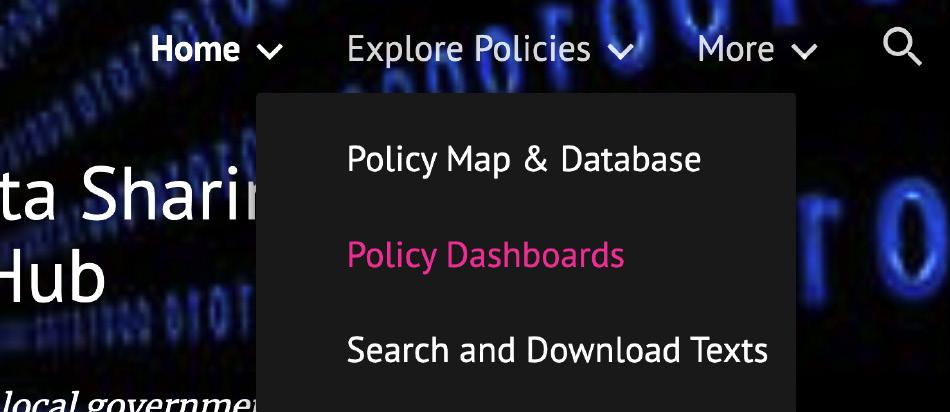
Figure 32. The “Policy Dashboards and Text Search” page can be found under the “Explore Policies Tab on the Platform Urbanism Data Sharing Policy Hub.
Figure 33. The “Policy Dashboards and Text Search” page contains embedded and externally linked access to data visualizations configured in Tableau and on Stae.

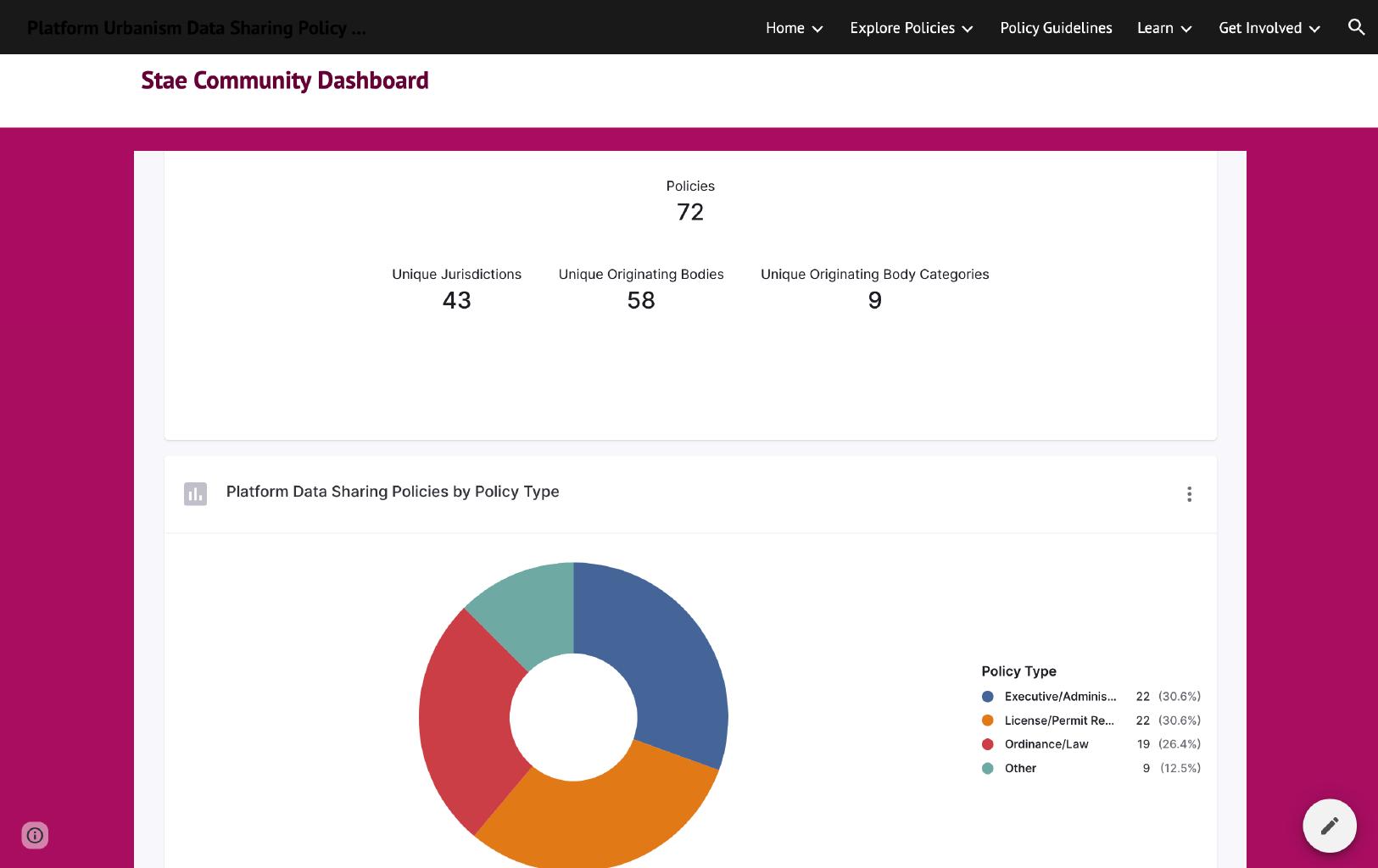
Figure 34. The “Policy Dashboards and Text Search” page contains embedded and externally linked access to data visualizations configured in Tableau and on Stae.
Reading the Policies and Textual Analysis
Beyond analyzing policy metadata our team also read the texts of these platform urbanism data sharing mandates88 and utilized basic search tools to perform some rudimentary textual and content-based analysis. Our observations and insights appear below.
Data sharing polices included in our policy research often shared common structural elements, language or both. The following “anatomy” of a platform data sharing policy provides a description of some common or
88 Sometimes the best way to contribute to a field is to do the boring, but necessary thing that no one else has been willing to do. Apologies to my research assistants who had done nothing to deserve having to join me in this task.
recurring elements and patterns that, while rarely all seen as part of a single policy were each observed in multiple policies.89
• “Data sharing” sub-sections of broader policies – As illustrated by the fact that only 12 out of 72 policies in our collection include the word “data” in the title, most of the local government policies included in our dataset are much broader regulations than just data sharing requirements. Policies in the dataset contain basic rules and requirements about operating a ride-hail fleet, offering short term rentals through a digital marketplace, or managing a fleet of deckles shared vehicles, with “data sharing” often appearing as just one subordinate section of or even an appendix to such broader regulations.
• Required reporting and reporting frequency/interval – Almost all policies collected include an explicit statement requiring data sharing or reporting. Data sharing sections typically state that a platform will report data at a defined regular interval and in a specified format.
• Goals/purpose related to data collection – Many policies provide some level of purpose or justification for platform data sharing towards the beginning of the “data sharing” section. For example,
Atlanta’s micromobility policy states that data will be used for
“enforcement and planning purposes”, while the City of El Paso’s goes further to actua
• Fields and Specifications - Data sharing sections will often specify fields or categories of information required, sometimes listing required fields as sub-items nested under a “required reporting” statement or in other cases sharing a tabular “specification” of field names, definition, and data formats. Similarly, in many micromobility policy data sections, data standards such as
GBFS and MDS will be referenced or enumerated as part of the documentation of required data formats. In more technically advanced local governments, there are sometimes more detailed
89 These items were captured as an exercise to help us understand the elements and components of how local governments are currently constructing data sharing policy documents and unless otherwise noted do not constitute an endorsement or rebuke from the author.
technical data specifications or API documentation included as an appendix or separate document.
• “Data privacy” section with privacy requirements for the platform – Data sharing sections often include or are followed by a section on “data privacy”. Interestingly, such sections commonly contain privacy provisions that the platform (rather than the city agency), must follow in the collection and handling of user data.
In the absence of a national privacy protection law, such language represents an interesting attempt by municipal governments to play a consumer privacy protection role, for example, by stipulating that platforms will not share PII with third parties or that customers/ users not be required to share unnecessary personal information, such as contact information, in order to utilize the platform service.
• Data privacy/protection section with requirements for the
agency – Often policies seek to protect data privacy in their own handling of platform data by precluding the platform from sharing personally identifiable information with the agency in the first place. However, with greater awareness of the risks of re-identification, some cities, like Louisville, KY have made stronger commitments in data sharing sections of platform regulations, including commitments to classify platform data received as “sensitive” by default and subject to handling in ways compliant with agency privacy, security, or handling policy.
Other cities, like San Jose, have created separate “data protection principles” or other privacy guidance specific to the platform data sharing program.
• Named agencies or departments and their roles – Most data sharing polices observed enumerated what agencies were in charge of a permit program, data collection, or both. For example, Boston’s short term rental policy specifies that the Inspectional Services
Department (ISD) is responsible for maintaining a short-term rental registry with platform data, in conjunction with the
Department of Information Technology (DoIT).
• Reporting and summary data sharing / open data publication
– Several policies explicitly reserved the right to share or republish
aggregated summary data derived from platform data sharing. Such language might also include commitments or requirements to include analysis of data in a “progress report” or other accountability document prepared by officials for the public, mayor, council, etc.
• Flexibility to update data reporting formats – Multiple policies contained language reserving the right of a named overseeing director to update data fields and formats required for data sharing as needed. Such provisions represent an attempt to acknowledge and account for the rapid pace of technology evolution and of possible future changes in industry best practices.
• Penalties or enforcement mechanisms - A few policies specify penalties for failure to comply with data sharing requirements, such as having a permit or license revoked or even monetary penalties, such as those included in New York City’s Taxi and Limousine
Commission’s ride-hail regulations.
• References to records policy, freedom of information laws – A handful of policies make references to freedom of information laws or records retention and disposal policies, typically to state that platform data collected will be subject to disclosure, retention or disposal in accordance with such existing legal frameworks.
• References to police - Similarly a few policies reference police or public safety departments, sometimes to state that data will not be shared, but sometimes to share that data collected by the platform may in fact be used by police under certain conditions.
For example, Washington DC’s micromobility policy includes a section on “Criminal Investigations” that stipulates that if vehicles are involved in criminal activity and “the proper legal request documentation is supplied by authorities (i.e.: subpoena)” then
“Permit Holder will provide the authorities with information subject to the Permit Holder’s internal procedures” and relevant
“laws as deemed appropriate”.90
90 For a more thorough discussion of the Mobility Data Specification and concerns about digital policing, see Kevin Webb, “Local Power in the Age of Digital Policing” (8/20/20) https://triangulator.org/blog/localpower-digital-policing/
Keyword and Best Practice Analysis
Following initial policy review, our team began exploring “best practices” and “tagging” municipal data sharing policy text through key words associated with certain practices of interest. These practices were informed by common or recurring “elements” of data sharing policies, as well as by policy evaluation frameworks from the literature. Specific research that grounded our best practice analysis included the papers “Sharing Data in the Sharing Economy: Policy Recommendations for Local Governments”91 and “The Case for Local Data Sharing Ordinances” both by legal scholar and project advisor Beatriz Botero Arcila as well as “Privacy and Security in Government Data Mandates” by G.F. Hans from the Center for Democracy and Technology.92 Privacy and data protection guidance from the Open Mobility Foundation93, and from specific city policies—like Los Angeles and San Jose’s privacy principles for mobility data and the City of Seattle’s privacy principles94—also informed our thinking.
The following key words or “best practice” elements were used:
• “Data collection purpose or justification” – Does the policy include language justifying data collection by explaining why platform data is needed and how it will be used?
• “Data minimization” – Does the policy include language seeking to minimize data collected to remove personally identifiable information (PII) or other sensitive information and to limit data collection to only information needed to fulfill stated program needs or government purposes?
91 Beatriz Botero Arcila, “Sharing Data in the Sharing Economy: Policy Recommendations for Local Governments,” SSRN Scholarly Paper (Rochester, NY: Social Science Research Network, January 26, 2021), https://papers.ssrn.com/abstract=3819441.”plainCitation”:”Beatriz Botero Arcila, “Sharing Data in the Sharing Economy: Policy Recommendations for Local Governments,” SSRN Scholarly Paper (Rochester, NY: Social Science Research Network, January 26, 2021
92 “Data in the On-Demand Economy – Privacy and Security in Government Data Mandates,” Center for
Democracy and Technology (blog), accessed April 12, 2022, https://cdt.org/insights/data-in-the-ondemand-economy-privacy-and-security-in-government-data-mandates/. 93 “Privacy Principles for Mobility Data,” Privacy Principles for Mobility Data, accessed April 18, 2022, https:// www.mobilitydataprivacyprinciples.org.“Using MDS Under GDPR | Open Mobility Foundation,” November 18, 2021, https://www.openmobilityfoundation.org/using-mds-under-gdpr/. 94 “About the Privacy Program - Tech | Seattle.Gov,” accessed April 12, 2022, http://www.seattle.gov/tech/ initiatives/privacy/privacy-program.
• “Formats, Fields, and Frequencies” – Does the policy include language defining a schema or data specification for data reporting, including data formats and file types, field names and definitions, granularity, and frequency of reporting?
• “Program transparency” – Does the policy require program transparency through measures such as progress reporting, publication of summary data, disclosure of data collected to the public, etc.?
• “Classification of PII and other sensitive information” – Does the policy define “personally identifiable” and “sensitive” information and/or comparable terms and require classification of such information?
• “Data privacy and protection” – Does the policy include language for appropriate permissioning and protection of private or sensitive information, including limitations on data access, use, and sharing and appropriate data security measures for data in transit and in storage?
• “Roles and responsible party” – Does the policy assign roles and responsible parties within the local government for the implementation and administration of the data sharing program?
• “Enforcement and penalties” – Does the policy create enforcement mechanisms including tangible consequences and penalties for noncompliance?
These key word and best practice elements were later expanded upon to generate “Policy Guidelines” shared in more detail in Part 3 of this report.
Example Keyword Analysis and Text Search
While rigorous natural language processing was not conducted under the scope of this report, the research dataset’s “text” field enables some basic keyword analysis and text search. Such analysis can be blunt, especially given the possibility of inaccurate text introduced during the optical character recognition process; however, despite limitations, the following figures hint at the possible and we hope, might serve to encourage the reader to utilize the “text search” tools available via the “Platform Urbanism Data Sharing Policy Hub” and/or download the PUDS policy dataset for further analysis of its “text” field.
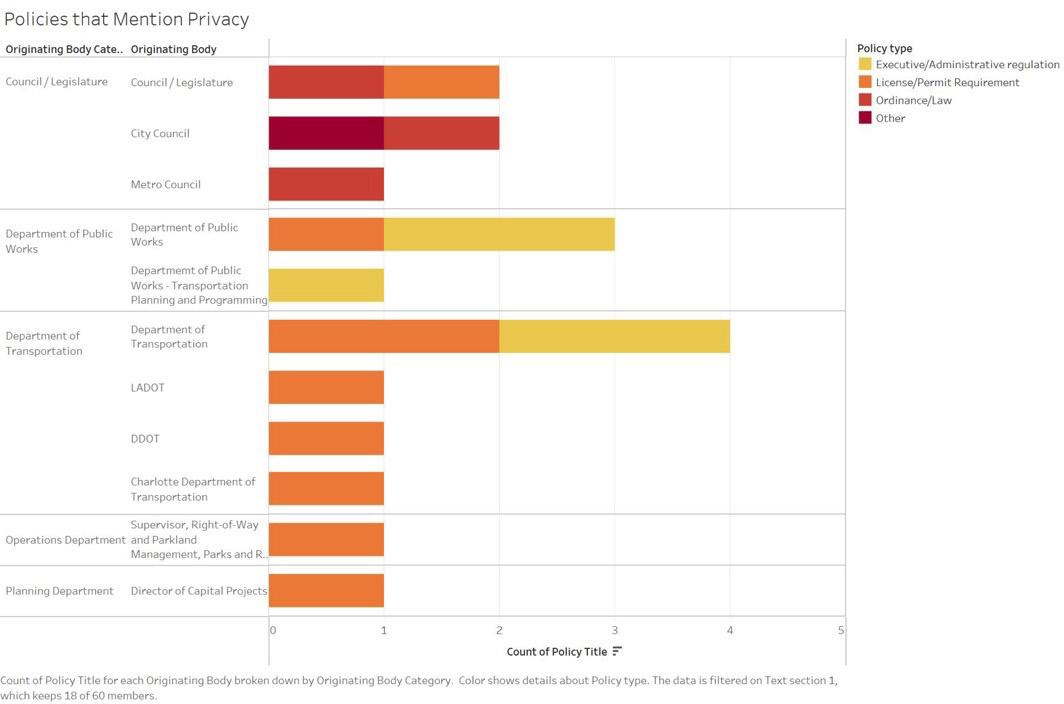
Figure 35. Policies that mention “Privacy”. The Chart shows policies containing the word “privacy” organized by originating body and color coded by policy type.

Figure 36. Policies that mention “MDS”. The Chart shows PUDS policies containing the acronym “MDS” organized by jurisdiction and color coded by policy type. Unsurprisingly, PUDS policies enacted by departments of transportation feature prominently.
Section 2.2 Conversations With Practionsers
Research Interviews with Practitioners
Beyond reviewing and analyzing the texts of data sharing policy mandates, it was important to our methodology to incorporate qualitative context by drawing from conversations with relevant individuals: primarily public officials, but also private sector employees and nonprofit advocates with direct experience planning or developing data sharing policy, implementing or administrating data sharing programs, negotiating the terms of public-private data sharing, or complying with data sharing policy requirements. Such interview-based qualitative analysis of city approaches to B2G data sharing and governance not only builds on PUDS policy research but also contributes to existing scholarship from others, including the work of Marina Micheli, whose paper “Public bodies’ access to private sector data: The perspectives of twelve European local administrations” which provides similar analysis from a European context and was influential in my thinking.95
Approach: Aggregating Relevant Practitioner Interviews from 2018 - 2022
My approach to incorporating qualitative insights from relevant individuals involved both utilizing previous research interviews I had conducted beginning in late 2018 through 202196, as well as conducting additional interviews more directly informed by the policy gathering and analysis described in the previous section.
95 In addition to budling on PUDs policy research, I see this qualitative, interview based research as also building on the work of scholars like Marina Micheli, whose paper “Public bodies’ access to private sector data: The perspectives of twelve European local administrations” provides similar analysis from a European context and was influential to my thinking.
96 Specifically, during my time as an employee for the government data management startup, Stae, a founding private sector member of OMF, I led multiple research projects seeking to better understand the needs of city officials seeking private sector data, including most prominently a project called “Dockless Decoded” through which I interviewed local government employees about their micromobility data needs.
Starting in late 2018 I began conducting videoconference and phone-based research interviews with various stakeholders involved in local government data sharing, with a particular focus on understanding the perceived data needs of city officials managing (or figuring out how to manage) shared micromobility fleets, which were then being deployed on streets and sidewalks for the first time by new private sector technology startups in urban jurisdictions across the country. In addition to interviews targeting micromobility program managers, from 2019 through 2021 I also conducted research interviews targeting various local government officials, particularly Chief Data Officers or other data-related IT officials, with a goal of documenting business-to-government (B2G) data sharing practices, needs, and policy requirements more generally. Building on this previous research, I conducted additional semi-structured interviews during the course of the TAPP fellowship, filling in gaps in the existing interview pool and targeting interview subjects represented in the platform urbanism data sharing (PUDS) research database. In total, 25 research conversations were conducted with relevant individuals about 10 of which took place from 2018 to 2019, 7 of which took place from 2019 to 2021, and 8 of which took place from 2021 - 2022.
Interview Pool at a Glance
To encourage candor, interviews were conducted with the assurance of anonymity for respondents. This section shares summary characteristics of the interview pool while respecting that anonymity, providing context about who is represented in interview results and who is not.
The majority of interview subjects (17 out of 25) were local government officials, the majority of whom (12 out of 17) had been involved in the development and/or administration of data sharing programs targeting micromobility platforms. While underrepresented, the interview pool also included government officials involved in the administration of data sharing programs targeting ride hail platforms (2 out of 17) and a government official involved in utilizing data from short-term rental platforms (1 out of 17). Some interview respondents had experience with other kinds of B2G or platform data sharing, involving agency use of autonomous vehicles data, cell phone location data, Yelp data, Waze data,
or housing and real estate data. This included two government officials (2 out of 17) not otherwise involved in micromobility, ride hail, or short-term rental data sharing policies or programs.
Figure 37. Interview Subjects by Persona/Sector. 17 out of 25 interview subjects (68%) were local government officials, with 5 out of 25 (20%) representing the private sector, and 3 out of 25 (12%) representing nonprofit or advocacy organizations.
Figure 38. Types of B2G or platform data sharing with which local government interview subjects were primarily involved. 12 out of 17 (70.6%) of local government officials interviewed were focused on micromobility data. 2 out of 17 (11.8%) were focused on ride hail, while just 1 out of 17 (5.9%) was focused on short term rental data sharing. Other kinds of data sharing were the primary focus of 2 out of 17 of the local officials interviewed.
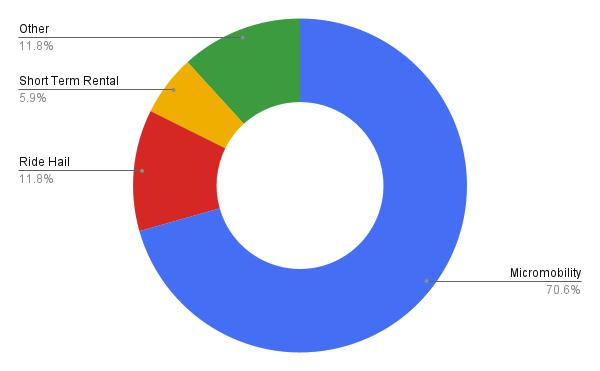
Government officials interviewed also represented a variety of agency and jurisdiction types. Just under 30% of public sector respondents (5 out of 17) were IT or Innovation department employees, an agency category not represented as an “originating body” for PUDS policy in the research dataset but nonetheless heavily involved in the implementation of data sharing programs. An equal number of officials interviewed (5 out of 17) were from departments of transportation (DOTs). Officials from planning departments made up 3 out of 17 (17.6%), with one respondent from a Special Board or Commission (5.9%).
Figure 39. Agency types represented by local government officials interviewed.
Because two jurisdictions were represented twice in the interview pool, the 17 local government officials interviewed represented 15 jurisdictions in the US and Canada including jurisdictions in 11 different states from a diversity of regions of the United States: the northeast (2) the mid-Atlantic (2) the Southeast (2) the Midwest (3) and the West (2). About half of jurisdictions represented (7 out of 15) were big cities with population over 500,000. Slightly more than a quarter (4 out of 15 or 26.7%) were midsized cities with population between 200,000 and 500,000. Slightly more than one out of eight jurisdictions (2 out of 15 or 12.3%) were small cities with population under 200,000. Additionally, 12.3% of local government interviewees (2 out of 15) represented County/Regional/State agencies.
Figure 40. Types of Jurisdictions represented by local government officials interviewed. The interview pool included local government officials from 15 different jurisdictions, representing a variety of population sizes and government types. 7 out of 15 (46.7%) of jurisdictions represented were Big Cities with population over 500,000. 4 out of 25 (26.7%) were Mid-Sized Cities with population between 200,000 and 500,000. Small cities with population under 200,000 represented 2 out of 15 (13.3%), while State Agencies and County or Regional Governments each made up 1 out of 15 or (6.7%) of jurisdictions reflected in the interview pool.
Beyond local officials, interviewees included a handful of conversations (5 out of 25) with private sector employees or former employees of technology companies involved in B2G data sharing programs, either as data processors for government or as platforms needing to comply with data reporting requirements. Finally, a few respondents (3 out of 25) were non-profit advocates, including both advocates and critics of city data sharing who had had some direct experience with program implementation.
Research Lines of Inquiry + Interview Questions
The goal of incorporating interviews into my analysis of PUDS policy was to uncover what we might learn from the perspectives of key stakeholders, and in particular, of local government officials, about platform data sharing requirements as a regulatory and governance approach. Although interviews took place over the course of 3+ years and questions and conversation styles were often individually catered, some consistency was
maintained across interviews via semi-standardized questions, organized into two broad “lines of inquiry” designed to serve that research goal: (1) “data sharing motivations and intent” and (2) “data sharing outcomes and results”
The first interview line of inquiry was focused on better understanding the motivations, justifications, and aspirations of public officials, and how those intentions and contexts gave rise to platform data sharing policies and programs. While intentions can be fuzzy, I was careful to ground discussion in the specific details of perceived data needs and policy design via the following questions:
1(a): Reason(s) for Data Sharing
• “Why was a data sharing program developed or sought out?”
– How and why did data sharing arise? What were the reasons for the program or what needs were identified that data sharing could address? Was there a specific event or circumstance that precipitated exploration of data sharing requirements?
1(b): Policy or Program Approach
• “What approach was taken to developing a data sharing policy
or program?” – Who was involved in developing the policy or program and how did they go about it? What are the details or requirements of the policy or program? How was this specific approach decided? What were the assumptions, constraints, and tradeoffs? How were those tradeoffs negotiated?
The second line of inquiry focused on the tangible aspects of data sharing program implementation and results, explored via the following questions:
2(a): Implementation
• “How is implementation going?” – How has implementation of the data sharing program gone? What data is being collected and how is it being used? By whom? What technical systems or tools are involved? What have been the successes and barriers?
What surprises or unexpected realities have you seen in the administration of the program?
2(b): Results and Implications
• “What are the tangible impacts and broader implications?” – what impacts or changes have come about as a result of the implementation of a data sharing program? What are the plans for the continued and future administration of the program? What do you see as successful or concerning about the development and implementation of platform data sharing programs in local government/cites and what are the broader implications of this approach from your point of view?
Together, these two lines of inquiry were designed to support a fuller understanding of platform urbanism data sharing mandates in local government as both a policy idea and as a technological and bureaucratic practice.
Interview Results: Synthesis and Discussion of Key Quotes and Observations
Utilizing the “Motivations and Intent” vs “Implementation an Outcomes” framing of the two lines of inquiry, key observations and quotes from various interviews were organized and synthesized into patterns, themes and insights, presented and discussed below.
Inciting Incidents: Responding to Platform Disruptions and Pressure from the Public and Leadership
Interview respondents described a variety of precipitating events, justifications, and goals that gave rise to data sharing policies or programs. A common pattern was that city political leadership was often pressured by an agitated public or by an incumbent industry (or both) to better understand or proactively manage sharing economy platform operations and impacts, either because of the sudden arrival of a new sharing economy platform in the community or because of ongoing or acute perceived incidents or impacts of an existing one.
In such contexts leadership and the public were looking for answers in the face of uncertainty and data was sought as a source for those answers. One interview respondent, an IT manager from a large city that had recently seen the arrival of e-scooters on their streets, described a typical sentiment:
“Making sure the city and the public knew what was going on was an argument for getting the data”
In a micromobility context a common pattern was that cities began considering data sharing requirements shortly after the deployment of micromobility fleets. Such requirements typically came as part of a pilot or permit program often enacted by the council or director of transportation or public works following complaints from residents concerning issues such as parking, equitable access to vehicles, hours and location of operation, or street safety. Data was seen as a necessary means of enforcing micromobility pilot program or permit rules intended to address these
issues. An official in a large city described the urgency felt at that time and the resultant expediency of permit development and enforcement.
In one day, two companies dropped hundreds and hundreds of scooters, so it made people mad. The council was upset. The public was complaining. The Director of Planning said if they [scooter companies] don’t comply with everything in our permit, including the data, then they can just leave.
Similarly, a Transportation Program Manager in a mid-sized city considering micromobility data requirements described the ineffectiveness of program rules without data:
We need to be able to measure compliance …We need a more proactive system.
For a public works official in a large city that relies on MDS data for micromobility program management, initial urgency wasn’t just about the ability to measure and monitor, but the ability to do so efficiently with limited staff.
I’m one person. I don’t have the time to regularly check in on all of this stuff on our streets but taking advantage of the data streamlines the monitoring process.
Outside of the micromobility context, the arrival of a ride hail or short-term rental platform in a community did not typically prompt the immediate adoption of a data sharing requirement. Respondents interacting with these sectors described a slower process through which issues of fairness or safety were raised by incumbents like taxi cabs or hotels or where indications of negative externalities, such as impacts on traffic or housing markets built up over time eventually leading to pressure to regulate and evaluate with data. For example, a policy manager in a large city noted the way in which a safety issue of public concern became the inciting incident for updated data sharing requirements for ride hail vehicles.
We had cases where drivers had been behind the wheel for 17, 18 hours a day, and there were actually a few high-profile crashes covered in the news, including one, at least one that was actually fatal. So leadership took that very seriously. We couldn’t just say to the companies ‘hey you’re responsible for making sure this driver doesn’t drive more than 14 hours, right?’ so we had proposed a way to sort of capture it with the data and combine data across companies so we could see what drivers total working schedule looked like, even if they drove for multiple companies.
Whether for a new micromobility platform or for ride hail or short-term rental platforms that had been operating for years, most city officials expressed frustration at the difficulty of addressing issues, enforcing existing regulations, or developing new regulations without data. The following quote was typical.
We were being asked to regulate, but we had a lack of information. Everything we knew about operations and impacts—even what we were hearing from the companies themselves—was like hearsay.
Data Justifications: From General to Specific
Public agencies citied a variety of different contexts and goals in justifying data sharing requirements placed on sharing economy platforms. These ranged from general to specific, but patterns emerged across interviews suggesting common objectives and rationales.
When describing a desire for platform data access broadly, multiple officials described a general need for the agency to be “proactive” to “understand impacts”, “know what’s going on”, etc. Sometimes this seemed to be motivated by a spirit of collaboration and an excitement for the possibilities of platform data as an informational asset. One city planner typified this sentiment.
One of the exciting things about bike share and also about scooter share is the enormous wealth of fascinating data about how people are using the city. Certainly, we’re very excited about the origin-destination stuff, ridership, user survey, demographic info of users.
At other times, broad justifications or motivations seemed to emerge from tensions over agency oversight, power and control. One policy manger in a large city put it this way.
The move fast and break things mantra of these companies— operating in a gray area at best, and at worst deliberately skirting rules—that really pissed cities off.
Those pursuing data on these more adversarial terms often sought broad access for purposes of enforcing existing rules on platforms in violation or perceived to be in violation of them and informing new regulation: “we knew data was a valuable asset for policy making”.
Even when officials spoke in broad terms about motivations, almost all also cited tangible problems or needs that they sought to address through data. These data “use cases” could be highly specific and might vary by platform type or by jurisdiction, but could each be sorted into one or more of the following “data use case categories” that emerged as patterns during qualitative analysis (see Table 7, next page):
Table 7 Data Sharing Use Case Categories
The following categories emerged during conversations with public officials directly involved in data sharing policy and programs in local government.
Data Use Case Category Description Data Frequency Examples Typical Interview Quote
/ Granularity
Compliance monitoring and enforcement
Program management and coordination Overseeing operations to ensure platform compliance with program or permit rules and with any other applicable laws or regulations.
Playing an active role in the operation of a program by defining what service looks like and how it is delivered in coordination with platform. Frequent, Granular Data
Frequent, Granular Data Reviewing micromobility compliance with no parking zones. Taking enforcement action against illegal short term rental units.
City responding to complaints. City defining zones for platform operations. Regular communication with platforms with a shared source of truth “The reason we want to have a ‘live’ or some sort of frequent time period for data reporting is so we can do enforcement on an ongoing basis.”
“The planning department was able to turn [Airbnb data] into an interactive online eligibility map—a nice page with tools and all sorts of stuff—so that if you as a host tried to open a new Airbnb and wanted a permit from the city you could look and see.”
Impact evaluation
Informed planning and policymaking Evaluating the impacts of platform operations—on public space, on infrastructure, on public resources, on markets, on neighborhoods, etc.—in order to identify problems and document benefits.
Using data to inform capital project, budget, or regulatory planning and decision making. Less Frequent, Aggregated Data Identify problems, such as increased traffic from a ride hail platform. Document benefits in ways that can justify continued platform operation, such as reduced carbon emissions from e-scooters. “The data helped us show that Uber was contributing to congestion. That’s what we could see. It was years later, where it’s like okay, we can now clearly see in these data that there are huge numbers of cars on the road, every day, many more than before.”
Least frequent, Summary Data Support new street projects, such as bike lanes.
Define the need for new polices, such safety regulations restricting the number of hours a driver can work in a day. “The data helps us generate plans for missing infrastructure where there is demand and where people are using [micromobility] and need safer streets.”
Policy Process: Players, Precedent, and Politics
In recounting the specifics of how data sharing motivations and needs were developed into policies and programs, officials described various players, precedents, pressures, and politics. These details give a fuller picture of the process.
Although our PUDs database tracks only one “originating body” as the agency associated with a given policy, conversations with officials revealed a more multi-lateral reality, with Information Technology (IT) departments often advising or leading in the development of data sharing requirements. This kind of collaboration between public servants with technical expertise and those with subject matter expertise (in transportation, housing, etc.) was sometimes named in policy but often came about informally through existing projects and relationships. One IT manager of a large city described his experience as follows:
As a member of the executive team with an enterprise view of data issues in the city, I got wind of the permit that the Transportation team was working on. Because of the work I had done with them previously with the Waze CCP program with those same people they were familiar with the benefits of third-party data and knew I was someone they could reach out to. And they said “hey we are going to ask for data” do you have any recommendations?
In addition to experience with B2G data sharing programs like Waze CCP, IT officials also described the benefits of other precedents. By the time of my interviews, transportation departments in particular typically had experience with data standards like the General Transit Feed Specification (GTFS) and the General Bike Feed Specification (GBFS) and through that familiarity knew to not just ask for data, but to define a data specification or even require an API. Additionally, networks such as the Civics Analytics Network (CAN) of City Chief Data Officers97 were cited as a source of data best practices and information sharing about what other cities were doing,
97 “Harvard Ash Center Launches Nationwide Network of Urban Chief Data Officers,” accessed May 15, 2022, https://ash.harvard.edu/news/harvard-ash-center-launches-nationwide-network-urban-chief-dataofficers.
especially in the context of micromobility, where the CAN had authored an open letter to “Urban Mobility Solution Providers” signed by 13 city data officers calling for the adoption of data standards to enable data sharing.98 Our same IT manager lends color.
Because of the Chief Data Officer Network I was able to reach out immediately to all of them and say ‘hey what are you doing with MDS’ I knew about the LADOT MDS open source stuff actually from my time doing things with the Waze CCP program that they were also involved in. I was able to pull in and connect with other cities, especially LA, making it so that we could get some information.
It speaks to ‘city power’—collective power I think. Me as [one city], I couldn’t really put a letter out like that on my own and if I did it wouldn’t have much impact. But to have 12 cities sign on alongside us to say the same thing through a network like that, I think it really helped.
98 “Civic Analytics Network Dockless Mobility Open Letter,” accessed May 15, 2022, https://datasmart.ash. harvard.edu/news/article/civic-analytics-network-dockless-mobility-open-letter.
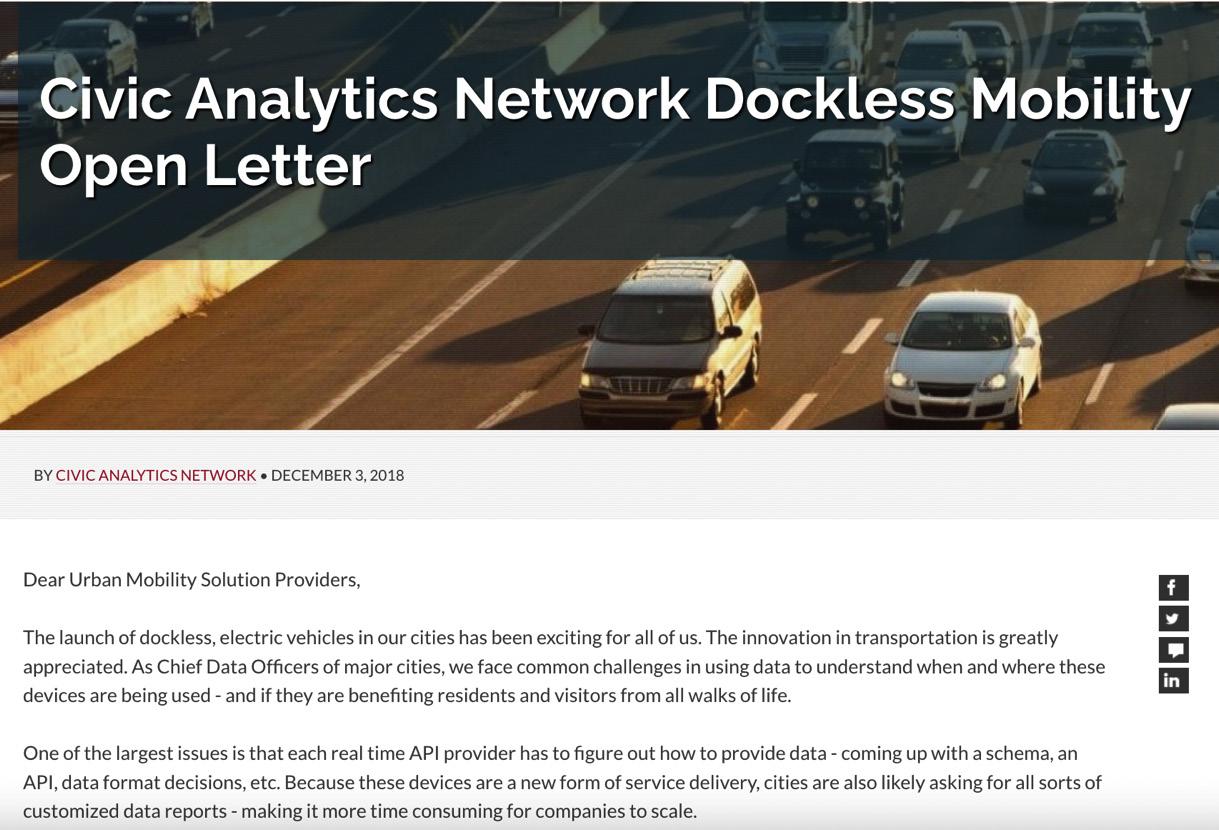
Figure 41. Civic Analytics Network Dockless Mobility Open Letter. Retrieved from https://datasmart.ash.harvard.edu/news/article/civic-analyticsnetwork-dockless-mobility-open-letter
The perceived need for this kind of “city power” and information sharing was common theme in my conversations, with non-technical officials in particular seeking guidance on data sharing considerations, as evidenced in these three quotes from three different officials.
They [micromobility platforms] are waving their hands a little bit about the data because I think they realized that all that language is “above our heads”. They are showing us all these pretty dashboards that they launched, and asking “is this good enough for the data requirements? It’s still a little above my head, but I know what APIs are and why they’re good.
Lime has a really basic heatmap which doesn’t really tell you anything. Some streets are bright red but there’s no key so without the data behind it you can’t tell what this kind of brightness means.
The most frustrating part is getting all of the data standardized.
Of course, the politics of data sharing was different for city negotiations and policymaking for micromobility companies when compared to ride hail and short term rental platforms. This was confirmed by multiple respondents.
There had been a lot of debate about rules for taxi companies and the data they gave us and I asked ‘Why can’t we ask for the same data from Uber and Lyft?’ Well, we knew from other cities if you push for data they may leave and that could be a bad look for leadership and for the Mayor because people would lose access to a service and mobility option they want. I think everyone liked Uber and Lyft especially in a car-centric city like [ours]. But with the scooters people just didn’t care as much, so that gave us more ability to ask for the data we needed.
While not every company threatened to leave, more than a few city officials noted common objections to data sharing requirements that platform representatives would make, as seen in these nearly identical experiences in two different cities.
The specific tensions that they originally gave to us at first were that business competition and “open data will be a problem for data sharing”. It changed at some point when they gave up on that and it became about user privacy and the 4th amendment of the constitution.
Trade secrets was cited as a reason against data sharing at first, and then later it became about privacy.
In the face of such objections, multiple interview respondents stressed the benefits of sometimes contested data sharing requirements to cite a “specific basis” and further described the benefits of policy processes that included review and approval by legislative or oversight bodies and otherwise allowed for public hearings or comment.
These rules all went through this public hearing process and public comment period where they had to be justified on a specific basis, so [ride hail platforms] didn’t have much of a leg to stand on to object.
In another example of the benefits of public comment, a city planner and analyst from a large city described how community feedback led to the inclusion of a requirement for an open API endpoint to which micromobility operators were required to publish GBFS data that anyone could access and use.
When the terms & conditions were being written, we had a public comment period. One of the comments we got from the civic tech community was to make sure that we have a publicly available API, so we made sure that happened. So at the beginning of the pilot, it was a lot of me talking with the companies to make sure we were getting it in the right format and in a timely fashion. The APIs allowed the civic tech team to develop on it and build visualizations on top of it and they have a meetup and had a “bikeshare hacknight” It was pretty interesting to see from the community what can be built on top of that.
In addition to public comment, another approach for bolstering legitimacy of data sharing requirements that respondents shared was building off of existing regulations, especially when it came to ride hail and short-term rental platforms that might be less willing to comply. Existing rules such as those requiring traditional “bread and breakfast” or “holiday” rental hosts to register with the city, or those requiring certain kinds of reporting from taxi cabs were perceived as harder for platforms to object to.
We already had records requirements for this broad category of business, so adding data reporting was an incremental step.
Whether drafting new micromobility policy or updating existing regulations, respondents verified what we had observed in our PUDS textual analysis: data sharing requirements were just a small part of the broader set of regulatory issues officials were dealing with. This meant
that without explicit attention, these provisions within larger laws or program or permit rules risked being treated as an afterthought. However, the subordinate nature of data sharing requirements was also cited as an opportunity for clear justification of B2G data sharing, with data needed to enforce or measure the rest of the rules developed. This appeared to be the case with the same IT manager whose policy process we began this section with.
As far as the actual permit that scooter companies had to follow in order to operate, I looked over the permit draft— and it might have been 20 pages or so—and I only did one page of it: the data sharing part. Everything else was done by transportation planners. Everything they did around fees and rules and everything like that they did based on their own knowledge and expertise on managing streets and in a way the data just supported that by making sure they could answer the council’s questions about the operations of the vehicles and that people’s safety was assured and that [scooters] weren’t cluttering the sidewalks.
Because all agencies represented in the interview pool were actively managing at least some B2G data, respondents were able to speak directly to the tangible realities of administration of relevant data sharing programs, including capacities, challenges, and successes.
One notable pattern was how few officials were typically directly involved in handling data feeds shared by platforms. Multiple respondents from small or mid-sized cities reported being the only person who directly handled relevant platform data, and even in large cities, teams were described as small, as in the following quote from a big city transportation manager, representing perhaps the largest data sharing team I heard described.
For most of the data, and certainly anything raw/sensitive, it was just a small team of like three or four people who would have access to all the data coming in. We had [the platforms] submit multiple tables so that we could easily partition access. And other people in the department, if it had to do with their day to-day-work they could have access to some of those tables. For anyone else, we’d produce summary/aggregated data that had no risk of privacy concerns.
This kind of limited access and strict set of user access permissions was a welcome observation in terms of minimizing individuals with access to potentially sensitive data. At the same time, it was likely just as much due to the limited number of local government staff with the technical abilities to work with data.
There was practically no one in the city who was capable of ingesting and making sense of that API data at that time. It is just a ton of data, and you have to know how to store it, analyze it, make sense of it.
Perhaps for this reason, a few of the interview respondents worked with third party intermediaries, such as a consultant, a university research partner, or most commonly a data processing software vendor. This was particularly true in the case of micromobility data sharing where multiple respondents reported utilizing the “white label” data management Software as a Service (SaaS) products of companies like Remix, Ride Report, and Populus that specialize in working with MDS and other mobility data and providing local officials with relevant maps, metrics, dashboards, and reports.99
One respondent, a public works employee responsible for managing the scooter permit program in his city, described the benefits of this setup.
99 The author here wishes to once again acknowledge his previous employment with a government technology company, Stae, that provided SaaS data management software to local government clients, including to a handful of micromobility clients. Stae was the author’s employer while many of the interviews described in this report were conducted.
I have a master’s degree in GIS but I don’t know anything about working with APIs. [A data management platform] is really helpful for that because I don’t have to figure out how to filter or query or map the data myself.
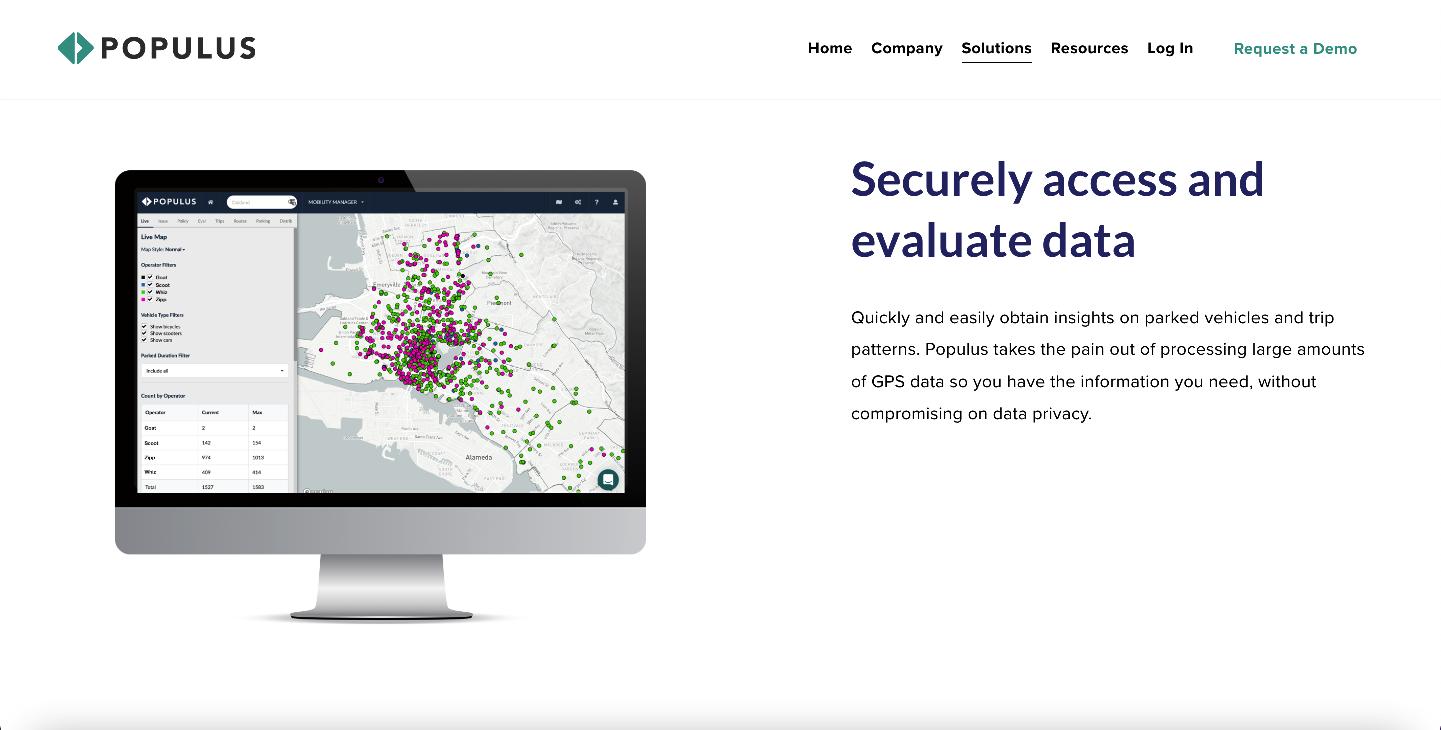
Figure 42. “Mobility Manager” product from Populus, a Software as a Service (SaaS) vendor that supports local governments in processing and using MDS data provided by micromobility platforms.100
Other respondents described alternatively (or additionally) building databases or data warehouses in-house, typically in coordination with IT staff, and working with analytics or Geographic Information Systems (GIS) teams to configure dashboards and maps with common public sector software tools like Microsoft Power BI, Tableau, and ESRI Arc GIS.
Almost all respondents who were managing micromobility programs were receiving data in the Mobility Data Specification (MDS) via a dynamically updated API that required a private “token” to access. This was true even of cities that had not explicitly required the MDS format or API feeds in their data sharing policy, a perhaps surprising fact nonetheless explained by the reality that it is easier for micromobility platforms to provide the same data format to every city than it is to have to customize a new feed for each jurisdiction in which they operate. This perhaps signals the rising power
100 “Mobility Manager,” Populus, accessed May 18, 2022, https://www.populus.ai/products/mobility-manager.
of technical standards, in some ways beyond policy, and also points to the ways in which large, standards-setting cities like Los Angeles impact the data infrastructures of smaller and mid-sized cities as well.
In contrast to the standardized API-based data sharing practices present in micromobility, officials receiving data from other platforms described a variety of formats and data transfer mechanisms for receiving data from platform companies, including “emailed excel spreadsheets”, a “simple URL returning a JSON file”, and a “SFTP Dump of .CSV files”.
Different agency respondents also reported different levels of technical data capabilities, both in terms of systems and infrastructure, as well as staff competencies. In some cases, this meant a learning curve for platform data sharing programs during the implementation process. One respondent described a regrettable data security practice that was quickly updated.
When I first started, we had a single password that everybody used to sign into the database.
This respondent worked for a big city on a transportation team and described operational improvements made by working with the IT department.
We were working with the IT department to really kind of evolve like our policies around, how do you analyze that data? how do you store that data securely? have you set permission levels on that data for who has access?
Eventually, according to this respondent’s account, this agency had among the most robust privacy and security practices I encountered during interviews, including strict access permissions, audits of all staff with access to sensitive data, and strict data sharing agreements requirements for granting access to any government employees outside of the specific agency overseeing the program.
Despite this positive evolution in this agency, the issues of operationalizing best practices in data management and governance, as well as issues
of inadequate technical infrastructure and staff competencies for fully leveraging platform data were both challenges named in multiple interviews. These challenges were often heightened in smaller or mid-sized cities, where staff and technology resources are more limited.
Of particular concern are the challenges of navigating certain kinds of requests for data: those from public records laws and those from police departments. Multiple respondents spoke about navigating sometimes overly broad open records laws that pose concerns for platforms and officials alike about the ability to withhold sensitive data from a public records request. In one interview the official described the approach of declining to ingest certain data from platforms to avoid that possibility. In other cases, legal determinations were sought proactively to ensure that agencies overseeing platform data sharing would have the discrepancy to exclude sensitive information from such a request. Police requests for access to platform data was only discussed in detail in one interview. In that conversation a transportation official from a large city described data protection policies and commitments to “purpose limited” use of the data as a basis for always denying such requests.
The police did sometimes come to us, but we always told them to get a subpoena and go to the company themselves…
While adamant that data sharing in his agency did not result in greater police access to data, when pressed on whether it might be a concern for data sharing programs elsewhere, he acknowledged a theoretical risk while remaining skeptical about the reality.
I can’t say if you asked the wrong official in the wrong city, maybe that would be more of a concern. That said, I think it’s a bigger thing in theory than it is in the real world.
Ultimately this official emphasized the importance for all platform data sharing programs of protecting data against police access.
A final implementation challenge documented was that of inconsistencies in data received from platforms. More than one interview respondent
shared the impression that despite their data-driven reputations, platforms often had inconsistent or even manual processes for generating data required for compliance with local government data sharing mandates, leading to potential issues with quality and reliability.
It shocked me how even at tech companies their data process were manual. For companies that swear by data and the use of data [this was surprising]...I think it might be an issue of resources that were not put toward compliance but instead dedicated elsewhere like growth.
When asked about outcomes and success stories of working with the data, respondents had a number of stories to share, typically corresponding to the data use case categories shown in Table 7 above, but with specific examples varying by type of platform overseen.
Micromobility managers shared examples of using MDS data for essential functions like assessing fleet or usage-based permit fees for platforms or investigating injuries or complaints. Data was also used to monitor basic program requirements like fleet caps, scooters parked in no parking zones, or operating in no-ride zones or after hours. Typically, these types of violations were noted and brought up in conversations with micromobility operators during regular check ins. However, in at least one case officials used data to coordinate in near real time with operators around issues of safety, such as scooters being left in a prohibited area in front of a school for the blind.
Officials also described the use of data to analyze and enforce requirements focused on equitable access to vehicles in low-income neighborhoods. Concerns over equity came up in multiple interviews, with the below quote typical of sentiments expressed.
As for the operators they’ll say the right things but when it comes to dollars and cents, they’re a private company doing all they can to make money. Will they continue to say the things
they’ve been saying, or will they operate in neighborhoods that are more affluent, more white, and already served by transit modes?
Following up on this concern, respondents also described how access to platform data was a way to help mitigate equity issues, at least to an extent. A public works employee shared his process for monitoring in the quote below.
I filter the status change feed and I look at the distribution and I see that they are not deploying the required 20% of the fleet in the [neighborhoods designated as equitable distribution zones], and I’m able to have a conversation with the operator about that, Lime, in particular (who has the largest fleet) has actually started deploying more vehicles in those zones after those conversations.
Another area of success reported by micromobility managers was in using scooter data to show demand for new multi-modal infrastructure improvements on city streets, often in line with the efforts of “Complete Streets” or “Vision Zero” initiatives. Officials reported using scooter data to justify new bike lanes (both temporary and permanent). Others described using maps and metrics from scooter programs to bolster grant application or present to city leadership in ways that make the case for capital improvements. Transportation officials may have sought to advance such projects for years but described data as a way to strengthen the case.
As frustrating as this is, we’ve come under fire for our bike projects. The council even took away our bike project budget. A major barrier with bike facilities has been that people see it [a new lane] installed, but they don’t see the usage. The scooter data shows us that use, so you can start to see it and show the skeptics that there is a need.
I see the scooters and the data they generate as one of the best tools I have for showing the facts in transportation and building the case for grants from the feds or prioritizing infrastructure projects to present to the Council.
Unsurprisingly, successful “use cases” described in interviews align closely with those documented by the Open Mobility Foundation (OMF) on their “What’s Possible with MDS?” page and in their “MDS Use Case Database.”101
Ride hail managers reported different kinds of successful data use cases, including monitoring and enforcement of ride hail fleet caps, of driver safety requirements, and of minimum wage laws. Another success story was relayed in the use of ride hail data to fact check claims made by platforms such as Uber and Lyft that ride hail was reducing traffic and emissions. After the data showed this not to be the case, regulations were put in place to correct for excess cars on the road by reducing the ride hail fleet.
Finally, success stories for short term rental companies include using platform data alongside city generated host registration data and eligibility to identify unregistered hosts and illegal rentals. Data was also used to analyze impacts on housing and to create a user friendly “eligibility map” to help hosts more easily determine if they are allowed to list short term rental units and if so, to help them register and navigate registration requirements, such as fire safety.
Perspectives on the Big Picture and Implications for the Future of Data Sharing Policy
In addition to sharing their experiences with platform data sharing policy and program implementation some respondents also shared thoughts on broader questions pertaining to data governance, public vs private power, and implications for the future. These sentiments are more philosophical and speculative in nature, and conversations on these topics were often more informal or even lighthearted manner. However, by providing a
101 “Introducing the MDS Use Case Database | Open Mobility Foundation,” October 20, 2020, https://www. openmobilityfoundation.org/whats-possible-with-mds/.
summary of interview discussions on topics like networked municipalism, data sharing mandates beyond e-scooters, and platform oversight beyond data sharing, I hope to provide relevant insight by gesturing toward some of the perspectives of local officials and other stakeholders.
The rise of the Mobility Data Specification (MDS) from a project of one agency, LADOT, to a global standard adopted in over 100 cities and governed via the Open Mobility Foundation (OMF) and its city-led governance board was clearly an inspiring or at least intriguing topic for many of those interviewed.
In one interview, I spoke to two respondents directly involved in OMF to understand what the organization means to them and whether its approach was perceived to have relevance beyond micromobility or even mobility. One described OMF admiringly as a “collective voice of cities to say ‘here’s what we want and here’s what we strive for’” in conversations with technology companies. Another respondent also involved in OMF felt as though a big part of the value of city-led data standards is that they can help cities be supportive of new services and technologies in the public realm, because data helps them evaluate and coordinate with technologies as they arise.
The big picture is about enabling cities to pilot things like delivery robots or drones and whatever the next big thing is, allowing them to test and learn from it without having to say “yes” or “no” before really having the information to understand, manage, and learn.
These ideas around “collective voice” and the enablement of data-driven city oversight of technologies beyond micromobility sparked a series of hypothesis about where data sharing might be headed next, what is unique about the mobility sector, and whether OMF-like organizations might coalesce in the future to enable B2G data sharing in other sectors.
One theory offered suggested that the imperative for sharing data with local governments might come from how regulated or “public” platform
operations are, holding that mobility is unique because it takes place in and depends on the public right of way.
I can see data sharing taking off in other sectors but there needs to be a real need for it. With mobility, it is and always has been and always will be something that happens in the right of way, so it is and should be extremely regulated.
This respondent went on to consider other sectors and situations in which data sharing, technical standards, and collective city voice might be needed, identifying existing relationships of oversight inherent in city permitting processes as a potentially relevant mechanism.
Anything a city permits could have an OMF structure to it. Like Airbnb for instance and building permits and land use, whenever a private startup or company comes in to do something novel in the public space or infrastructure, that’s when you might see data sharing needs arise.
The other interviewee, building upon these ideas, added a qualifier: is the company inherently generating data?
We have a whole variety of issues cities are responsible for and managing and dealing with, some pretty pressing issues—housing is on my mind quite a bit—but where there is technology to support it, that is where you will see the most movement toward data sharing. It will be interesting to see how the Airbnbs and Zillows of the world might play a role but there is so much about housing that is not technologically advanced or doesn’t have data to support the needs in the same way as we’ve seen in mobility.
A final thought in this abstract conversation focused on externalities and hypothesized that data sharing might be needed when a data generative platform company causes externalities that concern the public in ways that require regulation. The respondent speculated that safety was such an externality.
When it comes down to the public’s appetite for data sharing. The public cares about safety. A dating app or a LinkedIn doesn’t have a safety consideration. I think when you think about Airbnb it is important because they need some regulation for safety of people visiting for fire safety and smoke alarms.
At the other end of the spectrum, another interview involved a discussion of how cites could develop better frameworks for evaluating not just the benefit, but the cost of collecting data, and speculated about what it might take for a city hall to reduce data sharing requirements based on such assessments.
We need to develop better processes for reducing the amount of data. Cities aren’t good about looking like they’ve made a mistake, but we can’t be afraid to roll back requirements if after a period of time we learn that the data isn’t useful or needed.
Along these same lines, this respondent was interested in alternatives to data collection, as a means of platform oversight and/or collaboration.
I would love to see [platforms] offer a more consultive process for feature development, with city hall included in that process. Sometimes certain features can be a way to avoid the need for data collection or explicit regulation.
This kind of speculation seemed to envision a future in which certain kinds of platforms are more explicitly conceived of as public-private partnerships. Given that neither ride hail nor micromobility have ever truly been profitable, this respondent considered whether models involving public subsidy or public control of mobility platforms might arise.
In mobiliy it’s more about is this service profitable as a private company, or does it need public subsidy/control to run, especially to be run equitably.
Part 3: Findings And Final Thoughts
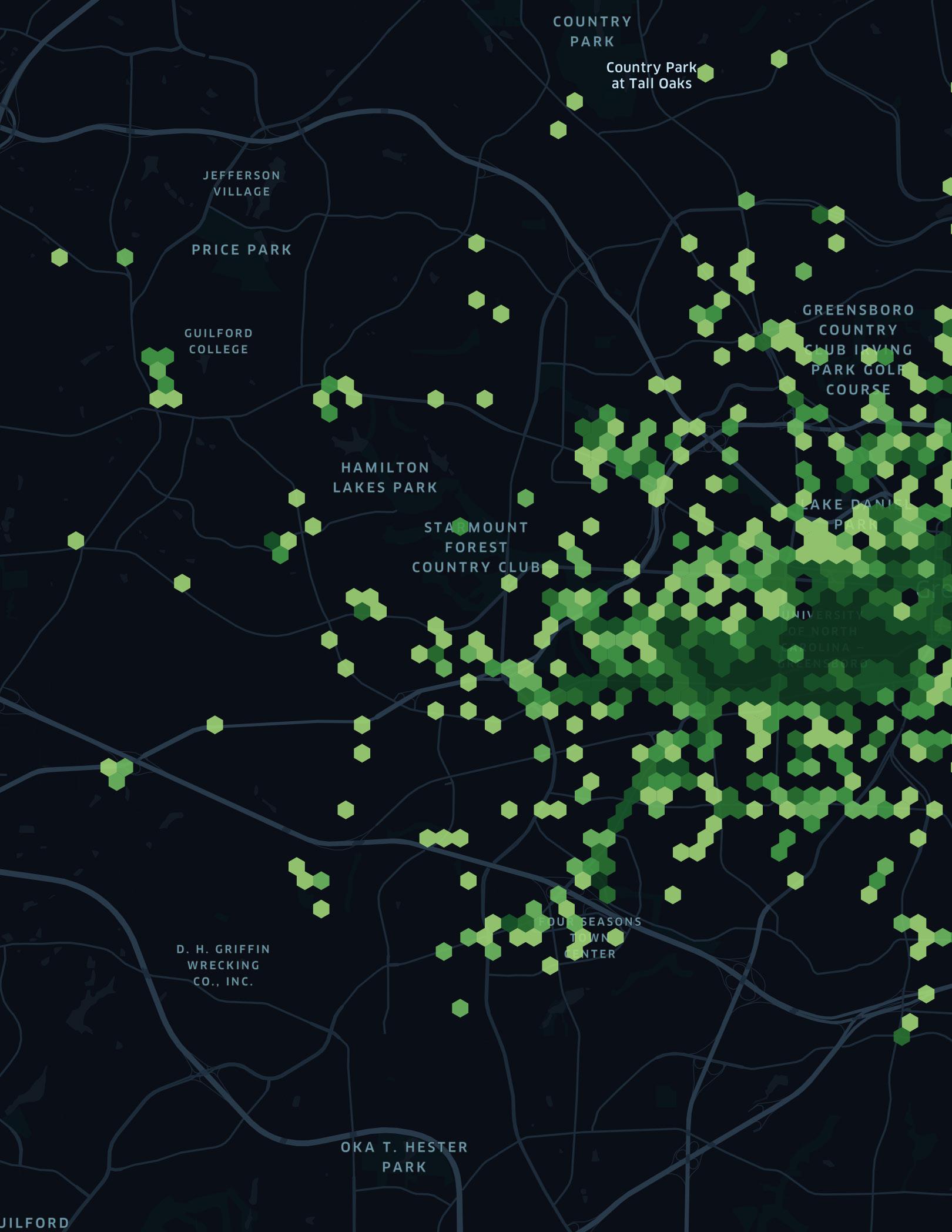
In this final part of the report, I present synthesized findings from my empirical research, including a summary of observations and insights, as well as a set of best practice guides developed for local government platform data sharing policies. I then take a step back and consider broader implications of platform urbanism concerning data infrastructure, digital rights, and technological sovereignty in the emergent smart city.
Section 3.1 Summary Of Findings And Presentation Of Policy Guidelines
The following insights and observations, including synthesized research findings, key takeaways, further questions for the field, and policy guidelines for practitioners represent the outputs of my empirical and scholarly research into local government data sharing policy.






